Stan Garfield's Blog, page 13
December 1, 2023
Knowledge Management Thought Leader 49 — Melissie Rumizen

Melissie Rumizen was an accomplished and highly respected leader in the field of knowledge management, and her memory is cherished by those who knew her. She began her career as a linguist in the United States Army. After completing ten years of active duty, she spent several years as an education and training specialist at the United States Army Intelligence School at Fort Devens, MA. In 1988, she joined the National Security Agency as part of the language test development section.
As an adjunct to her regular duties, she provided technical expertise in testing, research methodology and data analysis to numerous total quality efforts. This led to an interest in benchmarking, and she became NSA’s first benchmarking manager. Her interest in learning and sharing knowledge across an organization broadened her scope to include knowledge management. After NSA, Melissie worked for Buckman Laboratories. Her final role was senior knowledge strategist at SAIC.
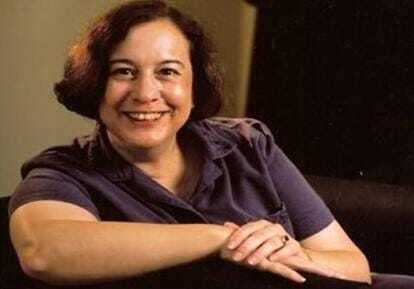 EducationRegents College, BS in General StudiesBoston College, MEd in Educational Research, Measurement and EvaluationCatholic University of America, PhD in Educational PsychologyProfiles
Obituary
Penguin Random House
World Knowledge Forum
Profiles in Knowledge
Books
EducationRegents College, BS in General StudiesBoston College, MEd in Educational Research, Measurement and EvaluationCatholic University of America, PhD in Educational PsychologyProfiles
Obituary
Penguin Random House
World Knowledge Forum
Profiles in Knowledge
BooksThe Complete Idiot’s Guide to Knowledge Management
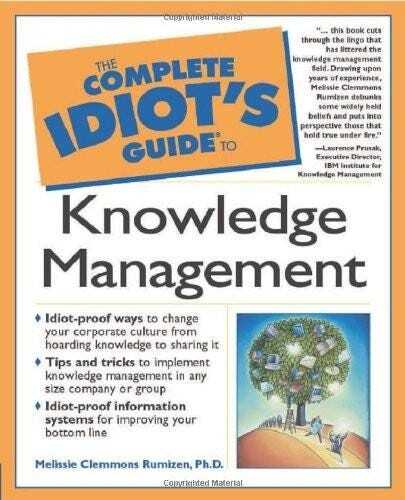
Marketing of High-technology Products and Innovations by Jakki J. Mohr, Sanjit Sengupta, and Stanley Slater — Chapter 4: Market Orientation at Buckman Labs
Next Generation Knowledge Management, Volume 3 by Jerry Ash — Chapter 5: Low tech, high touch knowledge management — with Gary Cullen
TributesDave Snowden
1 — Friend to many, passionate advocate of the human dimension of knowledge management. 2 — One of the larger-than-life figures in Knowledge Management. Early practitioner and all round one of the best networked people in the movement. 3 — This morning at KMWorld 2007 in San Jose we started off with a memorial to Melissie Rumizen. Steve Barth, Verna Allee and I read our own and other tributes to the background of photographs collected from her friends. Many people in that audience knew her directly or through her work so it was a sympathetic audience and a moving experience.Steve Barth — Community was everything to Melissie. It was the thing I loved most about her; not just what a good friend she could be, but how fiercely loyal she was about her friendships. She didn’t just expect her friends to be loyal to her in return. She expected them to be loyal to each other. If she deemed someone worthy to be her friend, she held them to a very high standard forever. If someone in her circle needed a job, a plug or a hug, Melissie made it happen.
Alice MacGillivray — Melissie Rumizen was a friend, a colleague, and an international consultant in knowledge management. This was a small celebration of the life of an amazing woman. Thank you for your support for cancer research. Yes, I completed the 60km walk in Vancouver! Lots of people stopped to read the official and unofficial biographies of Melissie, which she had shared when she was a special online guest in one of our MA in Knowledge Management courses at Royal Roads University.
Eric Mack — This year saw the passing of a well-respected and well-loved KM professional, Melissie Rumizen. This morning, before the keynote, Verna Allee, Steve Barth, David Snowden gathered to honor Melissie Rumizen, a KM Pioneer, Author, and respected KM Practitioner. I have Melissie’s book and even my KM professors refer to quotes in it. I’m sorry I did not have the opportunity to meet Melissie.
Bill Kaplan — I worked closely with Melissie Rumizen while she was with the KM consulting team led by Kent Greenes at the original SAIC. One key learning for me from Melissie was her perspective that there is no “perfect KM Strategy” for an organization. The idea that the strategy should and will develop through practical application and “performing and learning” in the job and on the job is a fundamental that anchors much of my current approach to KM consulting. I still refer to my copy of the book with her inscription to me on a regular basis. I visited with her in her home in Fairfax, VA shortly before she passed away…she gave me some advice and it is in this inscription. Melissie told me KM was not an easy discipline with which to work…and if I was to stay with it, I needed to be always a “source of learning” for my colleagues and my clients. Melissie was and remains, through her thinking and writing, a real practitioner in the field.
Content Preparing for Conversations with Melissie Rumizen Summary: Conversations with Melissie Rumizen Report on the Second Comparative Study of Knowledge Creation Conference Knowledge Management in the Real World: How to help your customers meet their goals — First in a series — with Bill Baker Knowledge Management Based on your Organization’s Approach to Life: Operational Excellence — OE networks, metrics, and more — Second in a series — with Jeff Stemke and Bill Baker Knowledge Management Based on Your Organization’s Approach to Life: Customer Intimacy — Focusing on your customers is the most value-added approach you can use! — Third in a series — with Bill Baker Need to Know: The KMM Q&A by Michael Robin The Evolution of KM at Buckman Laboratories — with M. Sheldon Ellis The knowledge: Melissie Rumizen Knowledge management and the plant: The why and how of it by Noria CorporationExpertise Location: Low tech, high touch by Jerry AshGarry Cullen was taking a break from his job as matchmaker for knowledge seekers and sharers in the Australia office of Lend Lease Corporation when he checked into the Association of Knowledgework’s K-Net discussion group. There he spotted another knowledge seeker, KM maven Melissie Rumizen, saying: “I’ve benchmarked expertise locators such as BP Connect and others. I’ve heard presentations from software vendors such as Tacit. What I’ve never heard is anyone who can tell me what value they have delivered. Is there anybody out there with experience with either an in-house expertise locator or one generated by software?”
Naturally Cullen responded, because that’s the way collaboration begins via ikonnect, the knowledge-sharing system available to nearly 10,000 Lend Lease employees and the employees of countless clients located across six continents. It is probably the most unique and effective system of its kind in the world, and it is not database driven.
Its fundamental principles are based on Lend Lease experience and objectives:
Databases fail to get knowledge movingThere is substantially more knowledge inside heads than databasesCustomer service is best achieved through the best available knowledgeConversations are the best way to transfer knowledgeKnowledge transfer begins with a questionCullen didn’t need to contact a third party to match Rumizen to the expert. He was the expert and — in Rumizen’s own words — he “bowled her over”.
Rumizen, who recently moved from Buckman Labs to SAIC, is an expertise-locator skeptic. She voices the following complaints.
Databases look internally. “Expertise locators, as with other databases, are too often based on the assumption that all knowledge or experience needed can be found internally,” she says. “That claim is impossible to prove or disprove, but we do know that most people rely on their own personal experiences in searching for people with answers, experience that often reaches beyond the bounds of the organization.”Databases are limited in scope. “Databases generally provide structured information such as names, photos, titles, brief job descriptions, previous work experience and contact information,” says Rumizen. “Unstructured information can include a person’s likes and dislikes or anything else a person feels relevant. However, the data is · limited due to the time it takes an employee to enter the information; and, at best an employee profile cannot cover the sum total of someone’s experience and expertise or match it to the unknown problems that may drive a future question. Compounding the problem, keeping such an inadequate database up to date is near impossible.”Databases are supply driven. “While stories that illustrate miraculous connections abound,” Rumizen says, “I’d prefer to focus on the types of knowledge needed and how best to provide it. For example, in a consulting firm, knowledge, documentation and contacts for previous projects are critical. What knowledge is needed on a routine basis? What knowledge would provide a high payoff? What knowledge is most critical to the organization’s key capabilities and strategy? Perhaps the best way to provide that knowledge is through multiple strategies to include communities of practice, project databases and other ways to link expertise.”People prefer networks. While an expertise locator may point to a given person’s experience or knowledge dreaded salesman’s cold call to someone they do not know”. People prefer to contact people they know or who are known to be approachable.Presentations Getting Started in Knowledge Management — Melissie’s BP Story Introducing: The Community Coordinator KMWorld 2004: Organization Readiness for Knowledge-Sharing Technology KMWorld 2002: Connecting People and Knowledge: Challenges and Strategies 11 Myths of Knowledge ManagementThere is a perfect knowledge management strategy for every organization.Having the CEO as a sponsor guarantees success.Organizational culture must be changed.Knowledge management results cannot be measured.Information Technology is Knowledge Management.People want to share knowledge and collaborate.Tacit knowledge must be made explicit.Knowledge does not change.Requiring everyone to speak English solves language and cultural barriers.Knowledge multiplies when shared.One cannot manage knowledge.12 Lessons LearnedOverall
If you don’t have a passion for KM, get out of the field. There are easier ways to make a living and/or drive yourself crazy.Keep learning. Regardless of whether someone is a novice or an old hand, there is always plenty to learn. I particularly like to scoop up ideas and processes to stick on a back shelf, hoping for a day when I can use them. In the meantime, I concentrate on continuing to learn.We are not as interesting as we think we are. People respond to action. It’s concrete; it’s real. Folks who sleep through your dazzling explanation of theory will come to life once you talk about how you plan to do something and the potential ROI. Much fascinates us as knowledge geeks but it often bores others to tears. Likewise, ditch the jargon. We don’t talk about KM at Buckman Laboratories. We do things that make sense for our business.Knowledge management is not a fad. To quote Verna Allee , “It is a business fundamental.” Smile sweetly at those who tell you that KM is outdated. Until something replaces knowledge as the means of production, KM in some fashion is going to matter.Communities of practice are simply another way of doing collaborative work. Success factors for a team, and a work group are the same as those for a community of practice. The catch is they way you do them is different.Simple is good. One of the most effective KM strategies implemented at Buckman Laboratories has been the after action review. Those short and sweet five questions have helped a non-reflective culture to become continuous learners. Granted, the underlying thought is sophisticated. But there’s no point in bringing that up (see point above).Strategic
Copy the strategic planning experts. They do SWOT analyses (Situation, Weaknesses, Opportunities and Threats). They think through the context of their organization their environment, competitors, etc. They think about the future. We have the same requirement for developing KM strategies as well as looking at the overall strategic plan for our organization.There is no perfect KM strategy for your organization. All too often we hold out for the Holy Grail of the perfect strategy. In any organization there are undoubtedly a number of potential strategies. You will not have the resources for all of them, so pick the ones that make the most sense, the ones you most likely can implement, the ones that will have a good ROI, etc.Once we get down to a specific KM strategy, however, we have two primary choices. As Ross Dawson says in Living Networks, “People’s knowledge can be embedded into documents, models, and software so that others can use it. People can be connected to others with relevant experience so that they can apply their knowledge to a specific issue. These two strategies, sometimes called connection and collection, are relevant to every business.”Self-interest is good. I’ve heard too many complaints about WIIFM, what’s in it for me. I adore WIIFM. If I can’t show why it is to someone’s benefit to do something, I encourage him or her to show me the door. Knowledge workers need to see a benefit for making a change. More power to them.Implementation
Plan on making mistakes. Implementing a new strategy, approach, tool, or process is an innovation. We need to allow ourselves room for a little judicious failure. Otherwise, we are not taking enough risks. We also need to analyze and learn from our mistakes.Culture can be a showstopper; get over it. I challenge anyone: for every barrier you find in a culture, you also can find an enabler. Look for the positive and build on it. You will never change the monolith of culture. The best you can do is target specific behaviors and help change them. Not only will you be more successful, you won’t antagonize people by talking about how bad your organization is.Leader of the packDespite changes in leadership and corporate strategy at Buckman Laboratories, the reliance on knowledge management as a key competitive advantage has remained constant. Recently named as a MAKE winner in North America, Melissie Rumizen says that the keys to success have been the value given to knowledge within the corporate culture, and how the company has developed and used knowledge throughout its history
Creativity for our customers
“Sustained creative work together is the basis of the success we have enjoyed and the key to our future.” — Stanley J. Buckman, founder of Buckman Laboratories.
At the end of World War II, Stanley J. Buckman left his position as president of Central Laboratories and started Buckman Laboratories. He chose the city of Memphis not only because it is on a great American highway, the Mississippi River, but because it is also near many pulp and paper mills — our target customers. Our first facility in Memphis was an old, remodeled duplex home. As one entered the building there were two laboratories on the left and four small rooms on the right, which served as offices and a library. The back porch had a stairway leading to the basement, the home’s manufacturing plant, and a small garage provided a storeroom. Buckman himself had a small office in a wing off the rear part of the building.
Despite the small building, the new company started with a strategic advantage. Prior to founding the company, a disturbing problem began to manifest itself in many paper mills in the US during the 1930s. The introduction of the recirculation of white water during pulp and paper processing produced significant economies. However, it also introduced a new challenge: the growth of micro-organisms in the water systems. The more efficient the water-recirculating systems became, the more suitable they were for the growth of micro-organisms that hampered production. Buckman Laboratories pioneered the use of biocides to control micro-organisms in this processing. This breakthrough gave the young company its impetus.
Within the organization, our research and development department was the backbone of the company. A standard joke was that it took a PhD just to sweep the floors at Buckman. The R&D; department provided the engine, technical expertise and innovation for our business strategy of product leadership. Our goal was to develop the finest, most innovative products that would bring in customers.
In contrast, however, we had a relatively small sales force. But as with our R&D; department, our first sales representatives held PhDs (with the exception of one with a Master’s degree). Buckman, himself a PhD chemist, felt PhDs had the best knowledge and expertise to present and explain our chemistry and its applications. Later we provided our sales representatives with mobile laboratories so that they could perform various tests right at the mill, rather than back at the home office. We also shared our technical expertise with our customers, often through seminars.
Dr B, as Buckman was known, is best described as an entrepreneur. In the words of John Pera, former VP of research and development, he had intelligence, creativity, a great scientific background, stamina, personality and business acumen. In addition to building the business, Dr B also stamped his values on the corporate culture. As author Edgar Schein noted, young organizations are, “the creation of founders and founding families. The personal beliefs, assumptions and values of the entrepreneur or founder are imposed on the people he or she hires, and — if the organization is successful — they come to be shared, seen as correct and eventually taken for granted.”
Dr B valued people with qualities similar to his — creativity, stamina and the ability to work as part of a team — who could do whatever was needed. One example in the early years was the designing and building of a new manufacturing facility to mercurate benzene in less than six weeks. A former VP, James Grannen, summed it up by saying, “If you needed extra effort, [Buckman associates] gave it willingly. If new ideas were important, they came up with them. If we needed to change directions, they got it done. Things got done, and they got done the right way.”
Across time and space
Sadly, in 1978, Buckman died, and his son, Bob, took over Buckman Laboratories. At the time the company was rigidly hierarchical with numerous heads reporting directly to Bob, necessitating much CEO attention. He made a decision to decrease the number of levels reporting to him and decentralize the company. He also recognized that although we had started to expand globally, relatively speaking we had yet to tap potential markets in many countries.
Bob instituted yet another key change in overall strategy: the dramatic increase of the sales force. The overall target initially was that the sales force would form 30–35 per cent of total employees. However, Bob understood that such a change had to be implemented gradually. Corporate sales in 1983 were $55.3m, by 2002 they were $335m; today our sales force and associated technical support personnel account for about 50 per cent of our workforce.
As we expanded globally into over 90 countries, the need to communicate and collaborate grew proportionally. Before the days of the internet and e-mail we sent our travelling PhDs to acquire and share quality practices. However, traversing the globe simply took too long. By the time the PhDs made it back to Memphis, some practices were outdated, or they might have learned other practices towards the end of the trip that they hadn’t shared with the first companies visited. There was also the wear and tear on the PhDs to consider. On one such trip to South Africa, Bob and Dick Ross, former VP of marketing, were sitting in the hot sun when Ross said wearily to Bob, “There has got to be a better way.”
So, in search of the better way and to enable us to communicate more efficiently, we started implementing global e-mail in 1984. We did not succeed until 1988. The IBM global network we used was cumbersome; the laptop computers we gave our associates weighed about eight kilograms. However, we finally had global e-mail.
In 1988 we formed the Knowledge Transfer Task Force, whose goals were to identify knowledge requirements for our business goals, translate these requirements into IT projects, and evaluate the global opportunities and implications of these projects. In 1992, we decided to use Compuserve, which was then a service for private users, for our corporate e-mail. Finally, we launched what became our knowledge-management system, K’netix.
With Compuserve came several additional capabilities. One was instant messaging. No matter where they were in the world, we could see which other associates were online. This started to create a sense that we were one global organization.
Forums, a bulletin-board application, were another bonus. If you posted a message on the bulletin board, everyone could see it, not just a few limited to receiving an e-mail. At that time Compuserve paid people to moderate discussion areas, but we decided that we would rather have our own employees moderate discussions about our business issues. We appointed section leaders for various primary industries, such as pulp and paper, leather, agriculture, industrial water treatment, and R&D.
Section leaders, mostly drawn from the then relatively few computer literate, met online at the end of every week. Their role was to create discussions in the forums, find answers to questions within 24 hours, check the daily activity and produce a summary of the weekly activity.
The head of our R&D; department at the time, Wally Puckett, mandated participation by R&D.; He made it clear that he expected everyone to contribute and that he knew the contribution of each person. This made R&D; visible to our far-flung sales representatives and to our customers, as well as raising the visibility of our product evaluations at individual customer sites.
The results were more than just having access to global e-mail. Over time, the social networks in the company grew and increased in density. As people learned who other people were and what they knew, direct contact via phone and e-mail skyrocketed. We began to not only have more face-to-face meetings, but also leverage the opportunities to meet in person. Our percentage of sales from new products, which we consider a measure of innovation, began to double. Other results included a 51 per cent increase in sales per sales associate and an increase of 93 per cent in operating profit per associate.
At the same time, in 1992, we realized that our strategy of product leadership was no longer viable. Much larger competitors were, as Bob puts it, eating our lunch. To survive and prosper we had to change. Consequently, we adopted the business strategy of customer intimacy. While we would maintain efforts in innovation, we decided to focus on providing customer-specific solutions that were the best solution for a reasonable price.
Improving output and quality
“We understand that no matter how well trained our associates are on an individual basis, they are not able to provide all of the solutions needed by our customers. However, these solutions either already exist somewhere within Buckman or the individual who can develop the solution is somewhere in our worldwide organization. We can therefore link all associates together through a knowledge-sharing system and work to maintain a culture where the sharing of knowledge is encouraged and recognized.” Steve Buckman, CEO.
In 1996 Steve Buckman took over the day-to-day running of the company as CEO, and in 2000 Kathy Buckman Davis became chairman of the board. While they honored and built on the past, they also had a new direction for our future. They brought a new emphasis on business processes that were simple, easy to learn and easy to do. They clarified links to business strategy, and how our strategy and processes produced an ROI. They also insisted on the critical need for systematic approaches across the corporation to provide a uniform level of services to our customers.
As we applied our strategy of customer intimacy, we realized that we needed a new mission statement to reflect it. While working together in our forums, our global associates discussed (at times hotly) what the mission statement should be. The results were:
“We, the associates of Buckman Laboratories, will excel in providing measurable, cost-effective improvements in output and quality for our customers by delivering customer-specific services and products, and the creative application of knowledge.”
We also refined our purpose, stating that it is to foster customer loyalty, attaining and maintaining long-term, loyal customers for mutual profitability and growth. Doing this requires us to link our success with our customers, demanding deeper relationships. It also reaffirms the importance of having skilled, knowledgeable associates.
In 1997 we began developing a suite of knowledge-based business processes to deliver customer-specific services that meet common customer needs. These processes have become a critical competitive advantage. As a key decision maker at a large global customer said recently, “I want to work with Buckman so that we can work with your processes.” In essence we now have two types of products: physical or chemical products, and people products focusing on business processes. Doug Linn, current VP of marketing, says, “The emphasis at Buckman Laboratories is on the process and the results. This is the difference our own customers are seeing. We have become good at differentiating by delivering customer-specific results.”
These processes, also applied internally, are now part of everything we do. Over the years they have become an integral suite that we have developed as a learning path and a complete course for our associates, primarily our sales representatives. However, we are developing an approach to give integrated training of the entire suite to all of our associates, which we are piloting with our US customer-service group.
In 1997 we also started the Buckman Learning Center, headed by VP Sheldon Ellis. At first the emphasis was on training, with a particular focus on distance learning. The same circumstances that necessitate global collaboration also make traditional classroom training both expensive and usually impractical. We were one of the first to venture into e-learning. Over time, however, our role expanded to provide broader support. “The Learning Center will serve as a change agent within Buckman: it will drive change or facilitate a complete transformation process. This can be a transitory role as a company embarks on a new strategy or is in the process of making an acquisition,” says Ellis. To carry out this goal, we home in on initiative-driven programs. We define these as public activities that drive a corporate-wide initiative, business plan or project. This is often an initiative that the CEO or senior management is passionate about and is being cascaded throughout the company. The Learning Center supports and drives these activities.
One example of such an initiative is our TeamToolz process. Several years ago we realized that our aptitude with communities of practice had not transferred with similar ease and success to employing teams. In fact, our track record with formal teams was lackluster at best. In 2000 we formed a team to develop a process, TeamToolz and we trained our first group of team facilitators to support it. An initial success in 2001 was our first global, coordinated launch of a new product line. The process this team established for new product launches has become the company standard.
The Learning Center is the process owner for TeamToolz. This autumn we will lead an evaluation of the first three years of TeamToolz and prepare to train even more facilitators around the world next year.
As more companies adopt knowledge management and distance learning, our customers have asked us to assist them in their KM and learning programs. We view this as an ideal fit with our overall strategy of customer intimacy, as it deepens and strengthens our partnership with them. It is also a superb avenue for learning what really matters to our customers, both strategically and tactically. In 2001 we formed a consulting arm within the Learning Center that works with our customer representatives to support our clients. As we are a business, we also work with external clients such as Johns Hopkins University and Samsung.
Lessons learned
Being a pioneer means we also have made our fair share of mistakes. It is part of our culture to be open about them so we will do better in the future. In line with that spirit, we can offer some lessons learned about knowledge management and learning:
Connecting people is more effective than building databases — Every paper machine in the world is different. Operating conditions at our individual customer sites vary enormously. We cannot rely on standard customer solutions. By connecting people, we can provide customized, expert solutions that tap our collective knowledge and do so quickly;Leadership is necessary but not sufficient — KM is a participative sport; everyone needs to play. However, Buckman Laboratories has been blessed with multiple generations of gifted leaders who have understood the value of knowledge and walked their talk;Training must support change — Our associates need training in how to carry out their new requirements. We deliver such training worldwide and in multiple languages;Discipline often trumps brilliance — Our methods and approaches are mostly absurdly simple and we rely on the most basic of information technology. What makes it work for Buckman Laboratories is our discipline of carrying out implementations across the corporation and our insistence on following our own methods. As we expanded globally, we learned that what we provide for a customer in one location must be available in other locations. An extraordinary process that, if localized, hurts us unless we are able to transfer it globally;Plan on serendipity — A truism is that you will always have unanticipated results; but you may or may not have anticipated results. Just as important is that you capitalize on the positive unanticipated results. Some of our most effective practices were serendipitous, but we had the insight to capitalize on them;Forget the jargon — If asked, most Buckman associates could not define knowledge management. We do not use the term or any other jargon within the company. Instead, we talk about business strategy, drivers and results, and how we accomplish those. It is better to live it than to talk it;The new becomes the old — What was once innovative becomes antiquated, entrenched way of doing things. If you implement a change that is adopted and becomes part of the corporate culture, it becomes part of the establishment. If you want to change that, you are back to square one of change management. One solution is to stop after a pilot, evaluate and make changes while things are still new enough to be relatively fluid;Significant change surfaces renewed resistance — Even your early adopters may regress to old behaviors if there is considerable change in the system. Significant change requires change management so plan for disruption;Never celebrate success; celebrate accomplishments — Celebrating success can signal that you are finished. KM, like continuous improvement and six sigma, requires ongoing attention. If you rest on your laurels, they wither;People will reward you — With the right tools, a supportive culture and freedom, good people will accomplish more than you had dreamed. Hire them, cherish them and give them the environment they need. They will repay you infinitely.[image error]November 17, 2023
Knowledge Nuggets: 100 KM Infographics
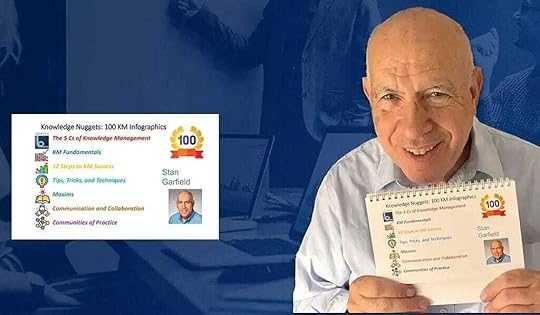
I am pleased to announce that my book, Knowledge Nuggets: 100 KM Infographics is now available. It is my fifth book, and I have also written chapters for four other books.
Published by Lucidea Press, this book offers the essential principles of knowledge management in easy to grasp infographics. It starts with the subject of my book for Lucidea Press, The Five Cs of Knowledge Management, and continues with KM fundamentals. The 12 Steps to KM Success are included, including details on each step. Tips, tricks, techniques, and maxims follow — and the book finishes with knowledge nuggets on communication, collaboration, and communities of practice.
Lucidea’s CEO Ron Aspe kindly said, “Stan’s book is a lively look at knowledge management fundamentals that will energize readers and inspire deeper dives into the discipline. We are happy to publish a book that represents a bit of a departure in format for Lucidea Press, while offering the expert guidance our readers have come anticipate.”
KMWorld 2023 attendees got signed print copies of the book. I invite you to download your free PDF copy.
Knowledge Nuggets: 100 KM Infographics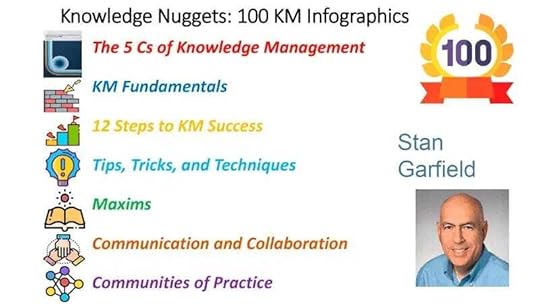 Dedication
DedicationFor my dear, departed friends, Max Bromley and Steve Carter. Their good nature, sharp wit, and positive outlook were a source of inspiration for me.
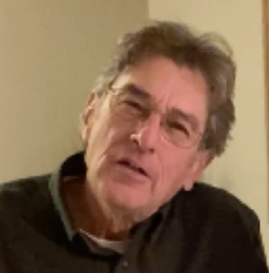 Max Bromley (October 29, 1948 — July 5, 2022)
Max Bromley (October 29, 1948 — July 5, 2022) Steve Carter (November 25, 1951 — June 7, 2016)Acknowledgements
Steve Carter (November 25, 1951 — June 7, 2016)AcknowledgementsI want to thank Lucidea for enthusiastically supporting this book and publishing it. Their ongoing commitment to knowledge sharing is impressive, and I am incredibly pleased to partner with them. I would also like to thank my editor, Sarah Nichols, for her support, effort, and skill.
IntroductionThe idea for this book came from noticing that when I posted an image with detailed text on social media, thousands of views ensued. In pondering the reasons why, I realized that my followers appreciate succinct visual summaries of the over 900 blog posts I have written since 2006. I like to illustrate each post with an image, and I use a similar approach with slides that I present. So, I decided to take the approach further by selecting icons for each point in the many lists I have created as part of my writing and speaking.
The content is supplemented by posts providing comprehensive details for each infographic. Links for each are available below. I encourage you to explore this additional content that expands on what appears in the book.
Table of Contents with Article LinksThe 5 Cs of Knowledge Management1. The 5 Cs of Knowledge Management
2. The 5 Cs of KM, Number 1: Capture
3. The 5 Cs of KM, Number 2: Curate
4. The 5 Cs of KM, Number 3: Connect
5. The 5 Cs of KM, Number 4: Collaborate
6. The 5 Cs of KM, Number 5: Create
KM Fundamentals7. The Knowledge Management SIRCL: 5 Core Activities
8. 15 Benefits of Knowledge Management
9. 5 Reasons KM Programs Start and 5 Reasons They End
10. 10 Actions Leaders Can Take to Get KM Going
11. The Future of KM: Five Foundations and Fifteen Fundamentals
12. 10 Trends in Knowledge Management
13. 10 Ways to Do Digital Transformation with KM
14. 10 Signs that Knowledge Management is Alive
15. 15 Key Issues in Knowledge Management
16. 10 Roles Needed for a KM Program
17. 12 Indicators of an Ideal Knowledge Library
12 Steps to KM Success18. 12 Steps to Knowledge Management Success
19. Step 1: 10 Ways to Build Expertise in Knowledge Management
20. Step 2: How to Identify the Top 3 Objectives for a KM Program: 5 Steps
21. Step 3: The 10 Commitments from Senior Leaders: Securing Support for a KM Program
22. Step 4: 9 Questions to Answer on People, Processes, and Technology
23. Step 5: Articulate Your Vision for How KM Should Work: 10-Part Vision for Knowledge Management
24. Step 6: Define the Knowledge Management Strategy: 10 Types of KM Strategies
25. Step 7: Define Compelling Use Cases: SAFARIS — 7 Use Cases
26. Step 8: Define KM Program Governance: 5 Elements
27. Step 9: Specify the Desired Modes of Knowledge Flow: 5 Modes of Knowledge Flow
28. Step 10a: Select and Implement KM People Components: 11 People Components
29. Step 10b: Select and Implement KM Process Components: 16 Process Components
30. Step 10c: Select and Implement KM Technology Components: 23 Technology Components
31. Step 10d: Knowledge Management Implementation: 5 Specialties to Use and 5 Plans to Develop
32. Step 11a: 10 ways to Innovate Key KM Processes and Tools to Implement a KM Strategy
33. Step 11b: 10 Steps to Implement, Improve, and Iterate a Knowledge Management Program
34. Step 12a: 10 Ways to Pay it Forward in KM
35. Step 12b: 5 Ways to Get KM Feedback and Ideas to Reuse
36. Step 12c: 10 Questions to Ask on a Resource Survey
Tips, Tricks, and Techniques37. 10 Tips for Starting a Knowledge Management Program
38. 10 Priorities for a KM Program
39. 7 Habits of Highly Successful Knowledge Managers
40. 10 Lessons Learned: Practical Advice for KM Leaders
41. 13 Insights on Knowledge Management
42. 10 Ways to Establish the Value of KM
43. 15 Ways to Sell KM in an Organization
44. 10 Ways to Create New Knowledge
45. 10 Ways to Retain Organizational Knowledge
46. 12 Tips for Building a Partnership Between KM and IT
47. 10 Indicators of a Knowledge Sharing Culture
48. 10 Guidelines for Collaborative Team Spaces
49. 15 Types of Knowledge Sharing
51. 10 Ways to Encourage Reuse
52. 10 Ways to Enable Lessons Learned
53. 5 Steps to Implement Taxonomy
54. 10 Ways to Provide Best Bets for Search
55. 16 Recommended Knowledge Management Books
56. 6 Questions to Answer for Personal Knowledge Management
57. 24 Ways AI Supports Knowledge Management
59. How to Motivate Knowledge Sharing
Maxims60. 16 Reasons Why People Don’t Share Their Knowledge
61. 10 Reasons to Share Your Knowledge
62. 12 Keys to Great Leadership: PATHBUILDERS
67. 40 Pitfalls to Avoid in Knowledge Management, Part 1
68. 40 Pitfalls to Avoid in Knowledge Management, Part 2
69. 40 Pitfalls to Avoid in Knowledge Management, Part 3
70. 40 Pitfalls to Avoid in Knowledge Management, Part 4
71. 40 Pitfalls to Avoid in Knowledge Management, Part 5
Communication and Collaboration72. 10 Ways to Communicate Without Pushing Content
73. 10 Tips for Successful Face-to-Face Meetings
74. 10 Questions to Ask Before Replying in Email
76. How to Build Your Personal Digital Brand
77. 10 Questions for Eliciting Success Stories
79. 10 Rules for Asking Others to Share Knowledge
80. 13 Use Cases for Collaboration
81. 8 Reasons for Working Out Loud
82. People Connections: 10 Types and 10 Attributes
83. 10 Course Details for a KM Training Plan
84. 5 Types of KM Documentation
Communities of Practice86. 10 Principles for Successful Communities
87. TARGETs for Community Management
88. 5 Types of Communities — TRAIL
89. 5 Activities for Community Participation — SPACE
90. 5 Requirements for Thriving Communities — SMILE
91. 5 Goals for a Communities Program — PATCH
92. 5 Expectations for Community Leaders — SHAPE
93. 5 Tools for Communities — SCENT
94. 10 Tips for Leading Communities
95. 10 Goals for Community Managers
96. 10 Tips for Managing Community Calls
97. 10 Reasons People Won’t Speak Up on Community Calls
98. Community Culture: 6 Types and 5 Recommendations
99. 10 Elements of a Practical Community Culture
100. Reviewing and Approving Requests for Communities
5 Questions5 Benefits[image error]November 10, 2023
Knowledge Management Thought Leader 48 — Katrina Pugh
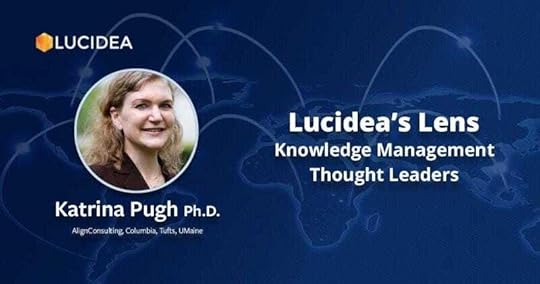
Kate Pugh is a convener, researcher, and manager with a successful record in artificial intelligence, large language models, strategy, agile product development, and organizational transformation. She has expertise in inclusive conversation models, quantifying the impact of conversation, digital transformation, information and metadata modeling, collaboration ROI assessment, change management, knowledge management, process improvement, journey mapping, social network analysis, and agile project management.
I first met Kate at a Working Knowledge Research Center conference at Babson College, when she was at Intel and I was at HP. I invited her to attend a debate between Tom Davenport and the late Larry Prusak at HP, when she was as Fidelity. Kate invited me to present to the Columbia University IKNS (Information and Knowledge Strategy) Master of Science program on multiple occasions.
She has been a frequent presenter on SIKM Leaders Community calls, at the Midwest KM Symposium, and at KMWorld. Kate started the SIKM Boston Chapter, and is a regular connector, convener, and contributor.
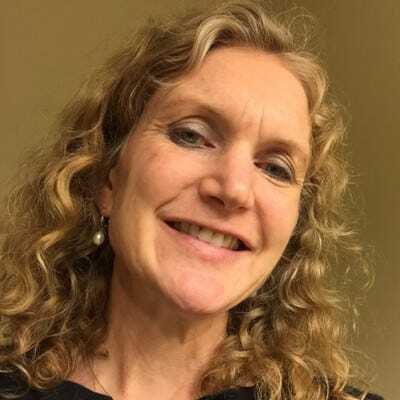 ExperienceColumbia University — Adjunct Faculty, 2011 — Present (Academic Director, 2012–2017)AlignConsulting — Consultant and Author, 2009 — PresentTufts University Gordon Institute — Instructor, 2023 — PresentPlastic Free Islands Network — Principal and Co-Founder, 2020 — PresentEY — Senior Manager, 2017–2019Earley Information Science — Senior Consultant, 2009–2016Fidelity Investments — VP of Knowledge Management, 2007–2008Intel Corporation — Senior Technical Program Manager, 2005–2007JPMorgan Chase & Co (Formerly BankOne Corporation) — First Vice President, 2003–2006PricewaterhouseCoopers and IBM Global Business Services (IBM acquired PwC Consulting) — Senior Manager/Principal Consultant, 1999–2003Dialogos — Director of Learning Strategies, 1997–1999Oliver Wyman — Principal Consultant, 1995–1997Monitor Deloitte — Consultant, 1988–1995EducationMIT Sloan School of Management — Master of Science/MBAUniversity of Maine — PhD, Ecology and Environmental Sciences, 2022Williams College — BA, EconomicsProfiles
LinkedIn
Columbia University IKNS
Twitter
Profiles in Knowledge: Columbia University
Books
ExperienceColumbia University — Adjunct Faculty, 2011 — Present (Academic Director, 2012–2017)AlignConsulting — Consultant and Author, 2009 — PresentTufts University Gordon Institute — Instructor, 2023 — PresentPlastic Free Islands Network — Principal and Co-Founder, 2020 — PresentEY — Senior Manager, 2017–2019Earley Information Science — Senior Consultant, 2009–2016Fidelity Investments — VP of Knowledge Management, 2007–2008Intel Corporation — Senior Technical Program Manager, 2005–2007JPMorgan Chase & Co (Formerly BankOne Corporation) — First Vice President, 2003–2006PricewaterhouseCoopers and IBM Global Business Services (IBM acquired PwC Consulting) — Senior Manager/Principal Consultant, 1999–2003Dialogos — Director of Learning Strategies, 1997–1999Oliver Wyman — Principal Consultant, 1995–1997Monitor Deloitte — Consultant, 1988–1995EducationMIT Sloan School of Management — Master of Science/MBAUniversity of Maine — PhD, Ecology and Environmental Sciences, 2022Williams College — BA, EconomicsProfiles
LinkedIn
Columbia University IKNS
Twitter
Profiles in Knowledge: Columbia University
BooksSharing Hidden Know-How: How Managers Solve Thorny Problems with the Knowledge Jam

Smarter Innovation: Using Interactive Processes to Drive Better Business Results with T.J. Elliott, Madelyn Blair, V. Mary Abraham, Catherine Shinners, et al.
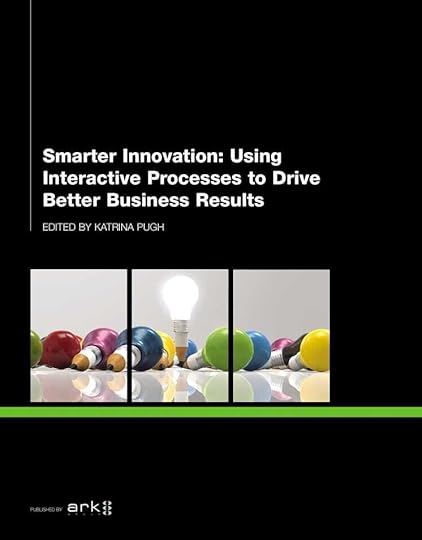
Knowledge is the Business (with Tom Stewart): Chapter 7 in Unlocking Value: Knowledge as a Strategic Management Tool edited by Fiona Prowting

What knowledge leader are you: Embedded, Consultant, or Product Entrepreneur? (with Glynys Thomas); Chapter 9 in Successful Knowledge Leadership: Principles and Practice edited by Helen Roche
 Content
Align Consulting
(archive)
LinkedIn Posts
LinkedIn Articles
APQC Roundtable:
How Technology Will Affect the Future of Knowledge Management
SIKM Leaders Community Posts
1
2
3
Podcasts
Knowledge Management & IoT, Analytics & AI
Reinventing Organizations Through Networks
Videos
KMCDC Monthly Meeting, October 22, 2020
Measuring Conversation’s Impact on Accountability, Innovation & Cohesion
The Role of Tacit Knowledge in Strategy and Design
Interview at Intra.NET Reloaded Boston
Knowledge Jam: Linking Social Protection to Employment
Radical Curiosity — Innovation Practices and Skills for the 21st Century
Where is Knowledge Management Headed?
Presentations
SlideShare
Connect or Curate? That is the question.
KMWorld
2019
A105: AI: Virtual Agents & Content
—
Slides
\2018
C204: Transforming the Working World With Knowledge Tech
with Greg Nemeth —
Slides
2017.
A305: The Math of KM: Modeling Margins
—
Slides
2014 A101: Knowledge Is the Business —
Slides
2013
C202: Igniting Innovation with Community, Social Media & Findability
—
Slides
2012
W15: Facilitating Knowledge Into Action
2011
C304: Channeling Insight Into Action
—
Slides
Enterprise Search & Discovery
2019
Virtual Agents & Document Intelligence
—
Slides
Video: Hand Classification vs. Auto-Classification
Video: Rich Metadata for Enterprise Content
Midwest KM Symposium
2020
Building Muscles to Improve Innovation Networks
with Sheryl Skifstad —
Slides
2019
New Frontiers in Conversational AI
2011
Insight: Sharing Hidden Know-How Takes Intention, Openness and Stewardship
—
Document
SIKM Leaders Community
2007–10 Knowledge Harvest Facilitation
with Nancy Dixon
2010–06 Sharing lost know-how — solve thorny problems with the Knowledge Jam
2011–08 Being the convener: facilitating tacit knowledge-sharing
with Roberto Evaristo
2011–10 Social Media in the Enterprise: the future is here — how can we make it work?
with Tom Short, Mary Abraham, and Peter Hobby
2015–02 How Great KMers are Innovation Conveners
2015–11 KM Trend Spotting: A Conversation
with Larry Prusak
2017–10 Collaboration and the Four Discussion Disciplines
2019–06 Conversational AI
2021–04 Translating Effective Sustainability Conversations into Network Design
Articles
Sustainability Conversations for Impact: Transdisciplinarity on Four Scales
Neural nets for sustainability conversations: modeling discussion disciplines and their impacts
with Mohamad Musavi, Teresa Johnson, Christopher Burke, Erez Yoeli, Emily Currie, and Benjamin Pugh
KM and the Internet of Things
with Ralph Poole
Four Discussion Disciplines to Drive Effective Online Collaboration
How To Create Social Impact Through Thoughtful Networks
Designing Effective Knowledge Networks
with Larry Prusak
Sharing hidden know-how: How managers solve thorny problems with the ‘Knowledge Jam’
Unleashing Unstructured Data’s Value: Mobilizing Us, Not Just Our Machines
Jamming with the Institute for Healthcare Improvement
with Jo Ann Endo
Harvesting Project Knowledge
with Nancy Dixon
Don’t Just Capture Knowledge — Put It to Work
with Nancy Dixon
The future of KM? Ask a Digital Native
In the Digital Fray, Don’t Just Converse. Collaborate!
Driving KM Design with Data
What is Knowledge Driven Digital Product Innovation?
Building Project Capabilities with Knowledge Networks
with Chivonne Algeo | Harry Linger, and Zaheeruddin Asif
Knowledge Jam: Three disciplines to beat the merger performance odds
Blog (archive)
Let’s Get Intentional: Four Disciplines for Online Discussions
Knowledge Jam in a Nutshell
Snapshot of Nonprofit Webinar Poll Results on Knowledge Networks
How Big Banks Can Fix Their Leadership Blindspots
Reducing Transition Risk Through Conversation-Intensive Knowledge Transfer
Co-CEOs: Potency and Peril
Shifting Learning and Development from Push to Pull
Building the Social Media Ecology: Part One and Part Two
Get Your Team to Share Information that Matters Most
Content
Align Consulting
(archive)
LinkedIn Posts
LinkedIn Articles
APQC Roundtable:
How Technology Will Affect the Future of Knowledge Management
SIKM Leaders Community Posts
1
2
3
Podcasts
Knowledge Management & IoT, Analytics & AI
Reinventing Organizations Through Networks
Videos
KMCDC Monthly Meeting, October 22, 2020
Measuring Conversation’s Impact on Accountability, Innovation & Cohesion
The Role of Tacit Knowledge in Strategy and Design
Interview at Intra.NET Reloaded Boston
Knowledge Jam: Linking Social Protection to Employment
Radical Curiosity — Innovation Practices and Skills for the 21st Century
Where is Knowledge Management Headed?
Presentations
SlideShare
Connect or Curate? That is the question.
KMWorld
2019
A105: AI: Virtual Agents & Content
—
Slides
\2018
C204: Transforming the Working World With Knowledge Tech
with Greg Nemeth —
Slides
2017.
A305: The Math of KM: Modeling Margins
—
Slides
2014 A101: Knowledge Is the Business —
Slides
2013
C202: Igniting Innovation with Community, Social Media & Findability
—
Slides
2012
W15: Facilitating Knowledge Into Action
2011
C304: Channeling Insight Into Action
—
Slides
Enterprise Search & Discovery
2019
Virtual Agents & Document Intelligence
—
Slides
Video: Hand Classification vs. Auto-Classification
Video: Rich Metadata for Enterprise Content
Midwest KM Symposium
2020
Building Muscles to Improve Innovation Networks
with Sheryl Skifstad —
Slides
2019
New Frontiers in Conversational AI
2011
Insight: Sharing Hidden Know-How Takes Intention, Openness and Stewardship
—
Document
SIKM Leaders Community
2007–10 Knowledge Harvest Facilitation
with Nancy Dixon
2010–06 Sharing lost know-how — solve thorny problems with the Knowledge Jam
2011–08 Being the convener: facilitating tacit knowledge-sharing
with Roberto Evaristo
2011–10 Social Media in the Enterprise: the future is here — how can we make it work?
with Tom Short, Mary Abraham, and Peter Hobby
2015–02 How Great KMers are Innovation Conveners
2015–11 KM Trend Spotting: A Conversation
with Larry Prusak
2017–10 Collaboration and the Four Discussion Disciplines
2019–06 Conversational AI
2021–04 Translating Effective Sustainability Conversations into Network Design
Articles
Sustainability Conversations for Impact: Transdisciplinarity on Four Scales
Neural nets for sustainability conversations: modeling discussion disciplines and their impacts
with Mohamad Musavi, Teresa Johnson, Christopher Burke, Erez Yoeli, Emily Currie, and Benjamin Pugh
KM and the Internet of Things
with Ralph Poole
Four Discussion Disciplines to Drive Effective Online Collaboration
How To Create Social Impact Through Thoughtful Networks
Designing Effective Knowledge Networks
with Larry Prusak
Sharing hidden know-how: How managers solve thorny problems with the ‘Knowledge Jam’
Unleashing Unstructured Data’s Value: Mobilizing Us, Not Just Our Machines
Jamming with the Institute for Healthcare Improvement
with Jo Ann Endo
Harvesting Project Knowledge
with Nancy Dixon
Don’t Just Capture Knowledge — Put It to Work
with Nancy Dixon
The future of KM? Ask a Digital Native
In the Digital Fray, Don’t Just Converse. Collaborate!
Driving KM Design with Data
What is Knowledge Driven Digital Product Innovation?
Building Project Capabilities with Knowledge Networks
with Chivonne Algeo | Harry Linger, and Zaheeruddin Asif
Knowledge Jam: Three disciplines to beat the merger performance odds
Blog (archive)
Let’s Get Intentional: Four Disciplines for Online Discussions
Knowledge Jam in a Nutshell
Snapshot of Nonprofit Webinar Poll Results on Knowledge Networks
How Big Banks Can Fix Their Leadership Blindspots
Reducing Transition Risk Through Conversation-Intensive Knowledge Transfer
Co-CEOs: Potency and Peril
Shifting Learning and Development from Push to Pull
Building the Social Media Ecology: Part One and Part Two
Get Your Team to Share Information that Matters Most
This is an interview between Wayne Turmel, author of the Connected Manager Blog on BNET, and Kate Pugh. The topic of the conversation was, “How do managers of virtual gatherings help get out tacit knowledge?”
What challenges do managers of remote teams encounter in building trust and getting out tacit knowledge?
A participant at a talk I gave recently came up to me and said, “Every time management asked me to train someone, I knew I’d be losing my role within the year. I became very cynical.” For many organizations, knowledge is power. You are valuable to your boss because you can do something she can’t simply automate or move offshore. It’s even more unsettling when you are remote and much of your brilliance is invisible to many of your teammates. So, when management asks employees and teams to talk about what they know, they may put up their guard.
On the other hand, motives for not sharing knowledge may be far less fear driven. I might not share with you because I don’t know what you need to know. (Or, I don’t know that I have any knowledge that could be even remotely valuable to you.) I want you to succeed, but I can’t see your whole context. “I didn’t know you might be meeting my client at the conference!”
What tools should they be using (and an example of how to use them?)
Great managers use both process facilitation and real-time facilitation to overcome challenges of protection or unawareness such as these. From a process perspective, managers invite the right people (people who know and people who could apply the knowledge), along with the right types of questions to draw out insights on a topic. From an engagement perspective, managers set a tone of curiosity, attend to the extremes (loud or silent), and model a language of respect.
For example, with the Knowledge Jam process, I call together a few participants before-hand to flesh out topics (for example, “What led you to know we were on the right track?” “What formulations didn’t work, and how did you change course?”). Also, I do one-on-ones, making sure that people come ready, and the more defensive people can imagine personal benefits of knowledge-sharing. Then, during the meeting, in real-time, as I type into the WebEx (or whatever), I ask questions using a posture of openness, rather than defensiveness. I help people to find language that’s both respectful and reflect-ful. I also reach out to the silent people, connecting the conversation to their interests, and invite them to jump in and ask questions or add comments. After all, it’s the participants’ conversation. I’m just a catalyst and cheerleader.
What are some ground rules leaders and facilitators need to establish in order to get true communication going?
Here is the list of ground rules I typically flash at the head of the Knowledge Jam conversation:
Be responsible for inquiring/pushing the collective thinking (“Common curiosity”)Use data (illuminate points of view or positions)Drive for clarity with questions, but not judgmentsSpeak one’s truthAsk the group for permission to digress or probe (use a “parking lot” liberally)Pay respect / don’t interruptPay attention (laptops, mobile devices off)Share outside the room only as agreed-upon by the groupThe bottom line is to prioritize the group’s shared knowledge ahead of yourself. I call this “common curiosity.” A ground rule I give myself is never to hold a Knowledge Jam conversation longer than 90 minutes. Anyone can pay attention for 90 minutes if the conversation is meaningful and aimed at informing action.
What are the 3–4 things (as specific as possible) that need to be said or done and what happens if they don’t?
Prework pays off: Having people enter the virtual room with a sense of purpose and curiosity is the result of the one-on-ones and topic-setting. (We all know how scattered conversations can be without an agenda or alignment on why we’re there.)
Openings matter: You have to set the stage (and even re-set the stage) to keep people thinking on several levels — our collective insights and the intrigue in the moment. (Our virtual lives are chaotic, and we need help shifting gears.)
Make it Explicit: Typing the notes in a structured way on WebEx (or whatever) slows the meeting down and makes people reflect more on what they and others have said. When you see your words captured or paraphrased, you know you’re being heard. (Have you ever attended a “leave no trace” meeting? Did you wonder if it all fell on deaf ears?)
Put knowledge to work: This isn’t the responsibility of the manager/facilitator but of the participants. But, you can increase the likelihood that action will follow if you give the people who are applying the knowledge to say what they’ll do with it, before they leave the virtual room. And it can’t hurt to keep those intentions alive in future plans or meetings. (After people have shared their insights, they hope to make an impact. Letting it drop without explanation can be like an insult.)
This seems quite elementary — plan, do, act — but when you do these steps intentionally and with the right tone your remote meeting participants will feel heard, respected and enlightened. And you’ll increase the likelihood that good ideas get put to work.
[image error]November 2, 2023
Knowledge Management Thought Leader 47: Wendi Pohs

As cofounder of InfoClear Consulting, Wendi Pohs provided systems design, software tools, and technical consulting services to help large companies integrate semantic technologies with their new or legacy systems.
She focused on taxonomy integration, text analytics, intranet and website search relevance tuning, graph database design, and metadata management, providing strategic taxonomy consulting, taxonomy development and maintenance routines, and relevance enhancements for search.
Wendi and I were at DEC (Digital Equipment Corporation) at the same time, but we did not know one another then. While there, she developed a competitive intelligence retrieval system, successfully used for years by the sales force. Ron Smart was one of her informal mentors at DEC. A KM thought leader in the 1980s, Ron passed away on March 10, 2013.
 ExperienceInfoClear Consulting — Chief Technology Officer, 2006–2022IBM — Consulting IT Specialist, 2003–2005Iris Associates/Lotus Development — Lead Taxonomist, 2000–2003American Mathematical Society, 1994–2000Digital Equipment Corporation, 1984–1994Education
ExperienceInfoClear Consulting — Chief Technology Officer, 2006–2022IBM — Consulting IT Specialist, 2003–2005Iris Associates/Lotus Development — Lead Taxonomist, 2000–2003American Mathematical Society, 1994–2000Digital Equipment Corporation, 1984–1994EducationUniversity of Michigan — School of Information
BAMILSProfiles LinkedIn Facebook Twitter Profiles in Knowledge: Digital Equipment Corporation BooksPractical Knowledge Management: The Lotus Discovery System with Gayle Thiel and Seth Earley
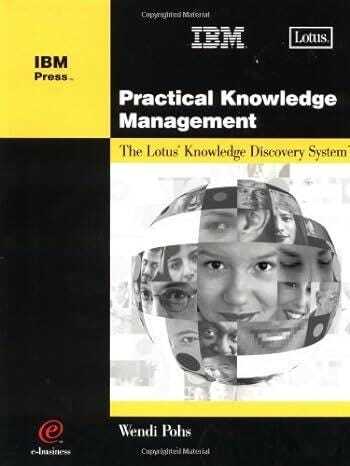
Enterprise Taxonomies: A Business Professional’s Guide to Taxonomies for Content Retrieval with Richard McCarrick
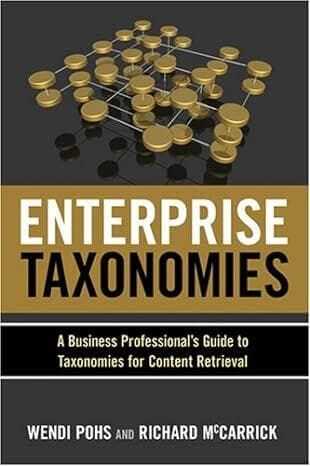
Upgrading to Lotus Notes and Domino 7 with by Tim Speed, Dick McCarrick, Barry Heinz, Tara Hall, and Matthew Henry
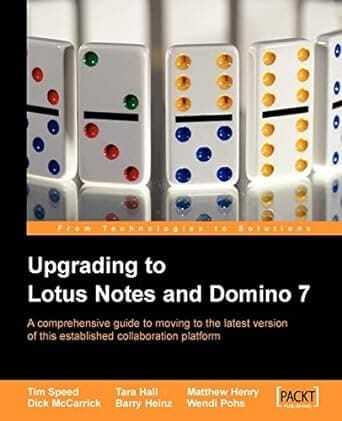 Content
Full Bibliography
Blog: Semantics in practice
Presentations
Taxonomies, Lexicons and Organizing Knowledge
Selecting a Taxonomy Management Tool
Taxonomies of Knowledge: Building a Corporate Taxonomy
The Gilbane Conference on Content Management Technologies 2004
IBM’s Intranet Search and Enterprise Taxonomy
Content
Full Bibliography
Blog: Semantics in practice
Presentations
Taxonomies, Lexicons and Organizing Knowledge
Selecting a Taxonomy Management Tool
Taxonomies of Knowledge: Building a Corporate Taxonomy
The Gilbane Conference on Content Management Technologies 2004
IBM’s Intranet Search and Enterprise Taxonomy
Enterprise Search Summit
2009 Migrating to a New Search Engine: A Case Study with Marilyn Chartrand2006 Integrating Search and Taxonomy: A Deep Dive — Workshop with Lisa Kamm Boosting Findability with Lisa Kamm2009 From the Lighthouse: Visioneering Taxonomies’ Future Merging or Integrating Multiple Taxonomies 2008 Yaksonomy: Talking About Taxonomies Ontologies and Folksonomies Executive Round Table:“Visioneering” the Taxonomy Horizon 2007 Everything You Wanted to Know About Auto-Classification (But Were Afraid to Ask) 2006 Buy, Build, Automate: The Great Debate 2005 Building a Taxonomy: The Process Enabling Your Taxonomy: Integration & Implementation 2008 W7: Auto-Categorization 2008 W16: Measuring Taxonomy Success 2006 Integrating Taxonomy & Search: Practices & Trends 2005 Workshop 4: Taxonomy Development & Usage 2003 Developing Taxonomies for Content Organization 2002 Taxonomies, Lexicons, and Organizing Knowledge Landing the Raven — Positioning the Lotus KM Implementation in the EnterpriseTaxonomies of Knowledge: Uncovering Hidden Themes in Existing Corporate DataArticles Leverage taxonomies for enterprise search using IBM OmniFind, IBM Classification Module, and SchemaLogic with Jochen Dörre, Josemina Magdalen, and Bob St. Clair Creating a rules-based classifier for Discovery Server 2.0 Taxonomy and Classification resources should sit on development teams Why I love Twitter Creating and Maintaining Machine-Generated Taxonomies in Human Organizations: Contributions from Research and Practice with Dick McCarrick and Michael Muller Issues in the design of software systems to support voluntary electronic communities with Michael Muller The Lotus Knowledge Discovery System: Tools and experiences Building a taxonomy for auto‐classification Importing a file system taxonomy into a K-map Selecting and configuring Discovery Server data repositories Developing Taxonomies for Content Organization


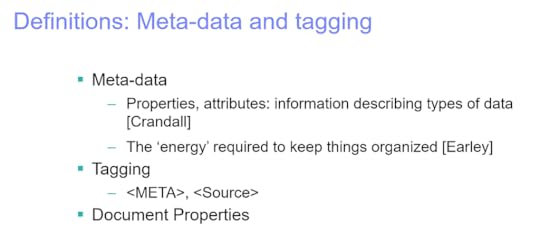
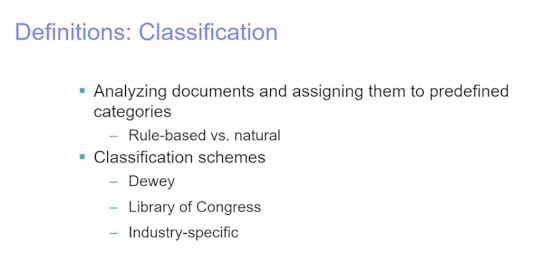
 [image error]
[image error]
October 27, 2023
Knowledge Management Thought Leader 46: Nirmala Palaniappan
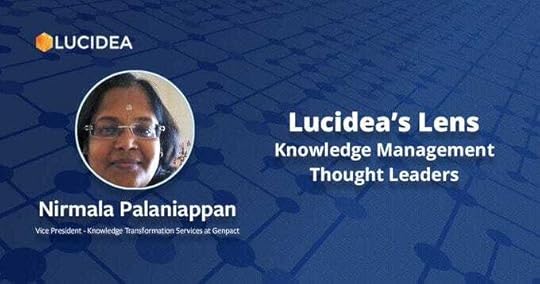
Nirmala Palaniappan (Nimmy) is passionate about knowledge, learning, design, and innovation and interested in product management, design thinking, business research, collaboration, culture, change management, consulting, process improvement, branding, and business strategy. She was awarded a US patent for the KM framework, methodology, and toolkit she conceived. Nimmy is currently Vice President of Knowledge Transformation Services at Genpact in Chennai, India.
Nimmy has expertise in creating and implementing intranets, community tools, expert locators, mobile apps, content management systems, internal portals, and Enterprise 2.0 tools. She also has skill in formulating KM strategies, creating a knowledge sharing culture, enhancing processes, designing and project managing technological implementations, and defining and monitoring benefits/measures.
Her specialties include knowledge management strategy, culture and change management, business process improvement, branding and advertising, KM technology concepts and enhancements, and business analysis. She wrote and presented several KM papers at national and international conferences on KM implementation, Enterprise 2.0, collaboration, toolkits, and blogging.
 ExperienceGenpact — Vice President of Knowledge Transformation Services, 2021-presentTAFE — Tractors and Farm Equipment Limited — Head of Knowledge Management, 2014–2020Oracle — Director, Social Enterprise/KM (Asia Pacific Technology Units), 2007–2014, BangaloreWipro Technologies — Lead KM Consultant. 2005–2007, Knowledge Manager, 2002–2005CG Smith Software Pvt Ltd — Knowledge Manager, 2000–2002EducationBangalore University — BE (Instrumentation Technology)Anna University — MBA (Systems and Finance), 1999Profiles
LinkedIn
Knowledge Management Online
Facebook
Twitter
Profiles in Knowledge
Award and Patent
2015 Awards: Most Influential Knowledge Management Professionals
US Patent 7657498B2
—
Business-aligned organizational knowledge management system
Content
Blog
— Aa..ha! [Thinking Inside The Blog!]
LinkedIn Articles
LinkedIn Posts
SIKM Leaders Community Posts
Videos
YouTube
Emerging Trends in KM and Digital Transformation in the Pandemic Era
— discussion with Rajesh DhillonArticles
Is Knowledge Sharing an Art or a Science?
The KM Elephant Story
The KM Elephant Story, Part 2
Impact of Videos on KM Engagement and Effectiveness
Elementary, My Dear Watson
Knowledge on Tap
What are the skills KMers need to have in future?
What’s in it for me when I share knowledge?
KM and its impact on Sales/Revenue
Chatbots and how they add value to KM programs
Tacit Knowledge Capture (Conversion of Tacit to Explicit Knowledge)
Lack of Cross-Functional Collaboration as a Barrier to KM
How can KM contribute to business goals?
ExperienceGenpact — Vice President of Knowledge Transformation Services, 2021-presentTAFE — Tractors and Farm Equipment Limited — Head of Knowledge Management, 2014–2020Oracle — Director, Social Enterprise/KM (Asia Pacific Technology Units), 2007–2014, BangaloreWipro Technologies — Lead KM Consultant. 2005–2007, Knowledge Manager, 2002–2005CG Smith Software Pvt Ltd — Knowledge Manager, 2000–2002EducationBangalore University — BE (Instrumentation Technology)Anna University — MBA (Systems and Finance), 1999Profiles
LinkedIn
Knowledge Management Online
Facebook
Twitter
Profiles in Knowledge
Award and Patent
2015 Awards: Most Influential Knowledge Management Professionals
US Patent 7657498B2
—
Business-aligned organizational knowledge management system
Content
Blog
— Aa..ha! [Thinking Inside The Blog!]
LinkedIn Articles
LinkedIn Posts
SIKM Leaders Community Posts
Videos
YouTube
Emerging Trends in KM and Digital Transformation in the Pandemic Era
— discussion with Rajesh DhillonArticles
Is Knowledge Sharing an Art or a Science?
The KM Elephant Story
The KM Elephant Story, Part 2
Impact of Videos on KM Engagement and Effectiveness
Elementary, My Dear Watson
Knowledge on Tap
What are the skills KMers need to have in future?
What’s in it for me when I share knowledge?
KM and its impact on Sales/Revenue
Chatbots and how they add value to KM programs
Tacit Knowledge Capture (Conversion of Tacit to Explicit Knowledge)
Lack of Cross-Functional Collaboration as a Barrier to KM
How can KM contribute to business goals?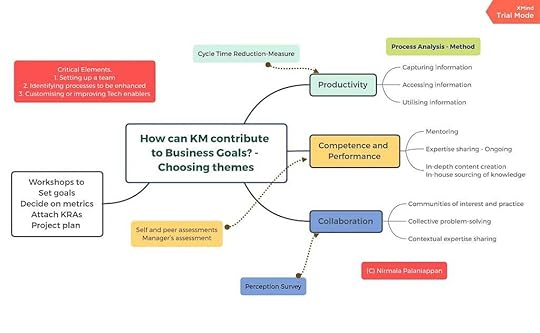 Content Management — The Three Phases
Content Management — The Three Phases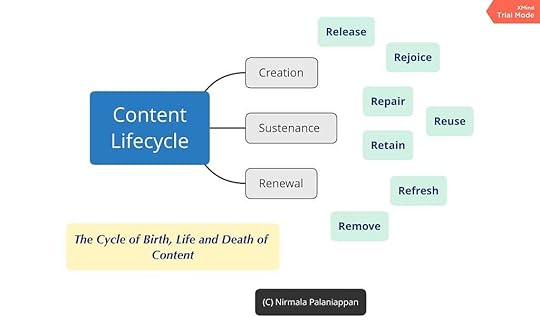 Building a Progressive Culture
Building a Progressive Culture Being Prepared — KM in the time of COVID-19
Being Prepared — KM in the time of COVID-19There are a bunch of things that organizations that are serious about surviving such calamities must pay attention to, in order to not be threatened by a major disruption in the way their employees connect, collaborate and conclude on the daily tasks. They must make sure that the KM function is given the necessary resources, freedom and support to put the following things in place. This will help them respond better when the situation demands that organizations use digital interfaces to bring people together.
Make constant reflection a prerequisite for all roles that are knowledge-basedMandate documentation of ideas, decisions, processes, deliberations and so on, on digital platforms that can be referred to by anyone to whom it is relevant, at any point of time (Don’t underestimate the power of writing things down. It improves clarity and sense of responsibility for the person writing it down. It improves the collective memory of the organization. It helps the organization learn from the past. It brings in more uniformity in the way employees understand things. It softens the blow of attrition and absence of employees. It helps in retrospective analysis and collective knowledge-building, among other things). Video capture would be a good or better alternative in some cases.Ensure that digital collaboration platforms are used by every business unit, cross-functional team and project team, including senior management committees etc.Give importance to content management systems and make it a part of the process to store, retrieve and utilize content related to operations, marketing, strategy and all other functionsBuild community management platforms that allow for internal communities of interest or practice to create and manage a body of knowledge on business topics of their choiceMake it easy for every employee to identify and connect with colleagues who work in related or associated areas. Encourage the constant seeking of knowledge from colleaguesInvest in content creation teams that focus on helping knowledge creators document, present and share their insights and learnings on a regular basisMake sure there is at least one knowledge champion who is tech-savvy, in each team, so they can constantly educate and inspire the team and get them to acknowledge the role that digital platforms play in enabling collaboration at all timesMake sure those who share knowledge and those who reuse knowledge are constantly under the spotlight and are appreciated, recognized and celebrated via these very digital platformsAdopt and use video collaboration platforms with white-boarding features when the need for conventional documentation is low or when the situation is too chaotic for typical documentationPresentations SlideShare A case study of the KM program at Oracle; Workshop on identifying the most appropriate KM strategy for your organization using metaphors — KM Australian Congress 2014 Design of an Expert Locator with Visual and Social Elements — Locating Subject Matter Enthusiasts via a Social, Integrated and Visually Rich Interface — Presentation at ICKM 2013 — A presentation on the design and implementation of an advanced expert locator with visually rich user interface and social elementsEnterprise 2.0 Personal KM and Cognitive Networking Application at ICKM. October 2010, Pittsburgh Serendipitous Links — First ISPIM Symposium on Innovation. Dec 2008, Singapore KM Challenge 04 — Driving Performance through Knowledge Collaboration — Conference Proceedings, Taronga Zoo, March 30–31, 2004 — Collaboration for the Creation and Exchange of Knowledge KMWorld 2020 — B402 — Using Video for KM Impact & Engagement SIKM Leaders, February 2021 — Tips & Tricks for Your Lessons Learned Program [image error]October 20, 2023
Knowledge Management Thought Leader 45: Moria Levy
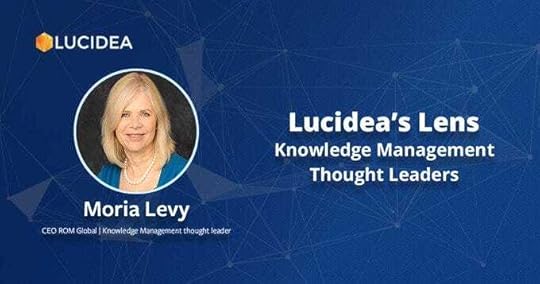
Moria Levy is the founder and leader of a KM consulting firm offering knowledge sharing, retention, and development projects. She is a KM researcher, author, speaker, and community leader, with expertise in knowledge retention and the KiSure methodology.
In 1998, Moria established ROM Knowledgeware, a firm specializing in KM with 40 employees. She developed new methodologies addressing intranets, lessons learned, knowledge retention, collaborative knowledge development, and more. These methodologies, based on field work, were later the basis for her research papers and books.
Moria led the first worldwide initiative for a KM standard: the Israeli KM standard SII 25006 in 2012. In 2015 she was chosen by the International Standards Organization (ISO) to lead a team of KM experts in developing a global KM standard. This resulted in ISO 30401 — Knowledge management systems, a comprehensive compass for knowledge management excellence.
Moria led the first initiative worldwide for high school studies specializing in knowledge management as part of information and data sciences studies, a program running in Israel for over a decade. As the Israeli KM Forum chair, she joined KMGN, the KM Global Network, turning her personal vision into the organization’s. She led KMGN in the development of two innovative KM courses, one focused on AI and KM, and the other on advanced KM methodologies. During her 2022 tenure as KMGN chairperson, the organization doubled from 12 to 25 involved countries and networks. Moria leads the “Designing the Future for KM” committee for KMGN and has helped establish Global Knowledge Week.
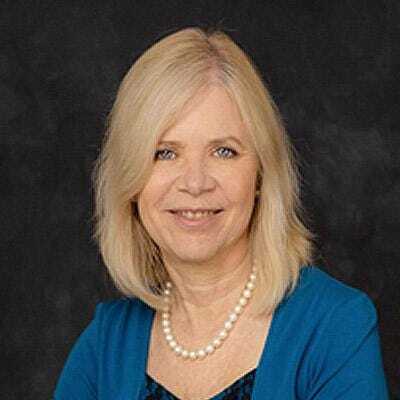 Education
EducationBar-Ilan University
Doctor of Philosophy (Ph.D.), Knowledge Management utilization in organizations, 2008–2010Master of Science (M.Sc.), Computer Science, 1988–1990Bachelor of Science (B.Sc.), Mathematics and Computer Science, 1981–1984ExperienceROM Global — CEO, 1998 — PresentKnowledge Management Global Network — Co-leader, 2021 — PresentISO (International Organization for Standardization): Chairman, KM experts committee, 2015 — PresentIsrael Knowledge Management Forum — Leader, 2009 — PresentIsraeli Air Force — DBA department manager, 1984–1990Profiles LinkedIn Twitter Communities and Conferences KMGN (KM Global Network) SIKM Leaders Community Posts PresentationsJune 2023 KM Global Network: Bringing a better future to KM. Together .September 2023 The ISO 30401 Implementation Toolbox KMWorld 2013 — A103: Knowledge Continuity & Retention — Slides (with Avi Kadem)Books21st Century Management: A personal blog
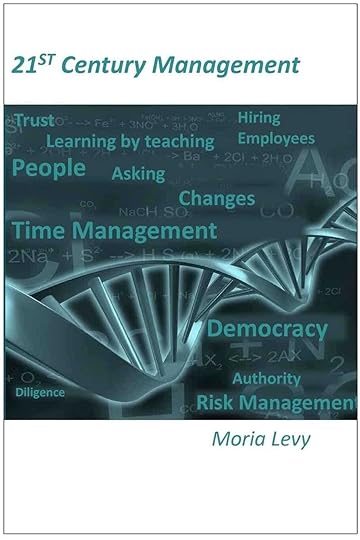
A Holistic Approach to Lessons Learned: How Organizations Can Benefit from Their Own Knowledge
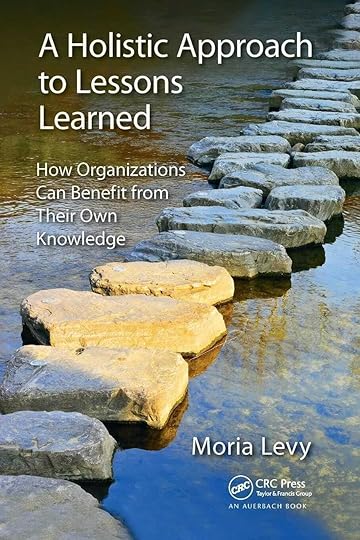 Book Chapters
Change Management Serving Knowledge Management and Organizational Development: Reflections and Review
— Chapter 12 in Global Practices in Knowledge Management for Societal and Organizational Development
Real Time Knowledge Management: Providing the Knowledge Just-In-Time
— Chapter 14 in New Research on Knowledge Management Applications and Lesson Learned
Management 2.0: Managing Knowledge Workers in the 21st century
— Chapter 2 in Implementing New Business Models in For-Profit and Non-Profit Organizations: Technologies and ApplicationsOther Content
Site
Blog: Knowledge Management: Managing in an era of knowledge
LinkedIn Articles
LinkedIn Posts
LinkedIn Documents
Because You Need to Know Podcast
Videos
Moria Levy — YouTube
ROM Knowledgeware — YouTube
KMGN — Knowledge Management Global Network — YouTube
Sharing tacit knowledge in the new virtual world
Interviewed by Santhosh Shekar
Part 1
Part 2
Part 3
Articles
Semantic Scholar
ResearchGate
Google Scholar
Academia.edu
2know Newsletter
Articles
Book Reviews
Generative AI
A Conversation with Chris Collison
Journal of Knowledge Management
Stairways to heaven: Implementing social media in organizations
Knowledge Retention: minimizing organizational loss
Web 2.0 implications on Knowledge Management
Electronic Journal of Knowledge Management
Leveraging Knowledge Understanding in Documents
Journal of Knowledge Management Practice
Effective Content Organization of a Portal
A Case Study of Successful Implementation of a Learning Model
ISO 30401 Implementation Toolbox
Book Chapters
Change Management Serving Knowledge Management and Organizational Development: Reflections and Review
— Chapter 12 in Global Practices in Knowledge Management for Societal and Organizational Development
Real Time Knowledge Management: Providing the Knowledge Just-In-Time
— Chapter 14 in New Research on Knowledge Management Applications and Lesson Learned
Management 2.0: Managing Knowledge Workers in the 21st century
— Chapter 2 in Implementing New Business Models in For-Profit and Non-Profit Organizations: Technologies and ApplicationsOther Content
Site
Blog: Knowledge Management: Managing in an era of knowledge
LinkedIn Articles
LinkedIn Posts
LinkedIn Documents
Because You Need to Know Podcast
Videos
Moria Levy — YouTube
ROM Knowledgeware — YouTube
KMGN — Knowledge Management Global Network — YouTube
Sharing tacit knowledge in the new virtual world
Interviewed by Santhosh Shekar
Part 1
Part 2
Part 3
Articles
Semantic Scholar
ResearchGate
Google Scholar
Academia.edu
2know Newsletter
Articles
Book Reviews
Generative AI
A Conversation with Chris Collison
Journal of Knowledge Management
Stairways to heaven: Implementing social media in organizations
Knowledge Retention: minimizing organizational loss
Web 2.0 implications on Knowledge Management
Electronic Journal of Knowledge Management
Leveraging Knowledge Understanding in Documents
Journal of Knowledge Management Practice
Effective Content Organization of a Portal
A Case Study of Successful Implementation of a Learning Model
ISO 30401 Implementation Toolbox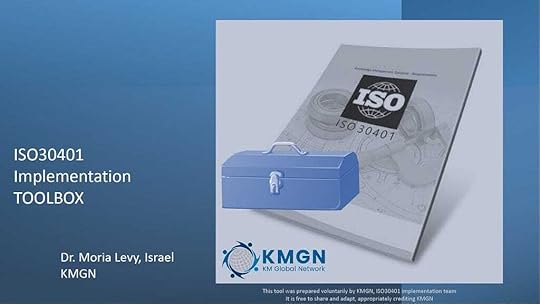
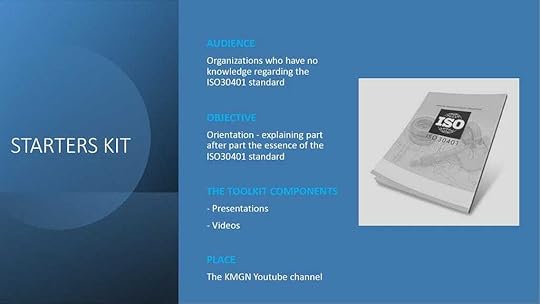
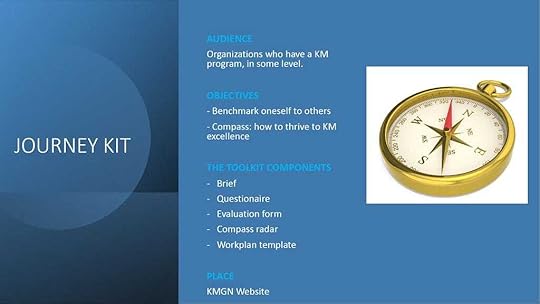
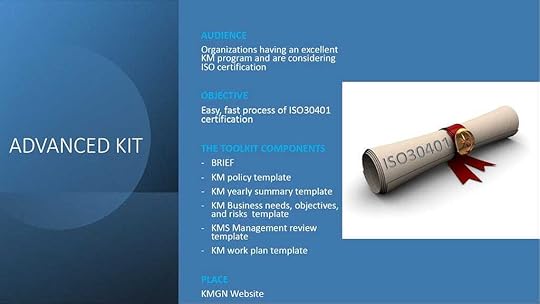
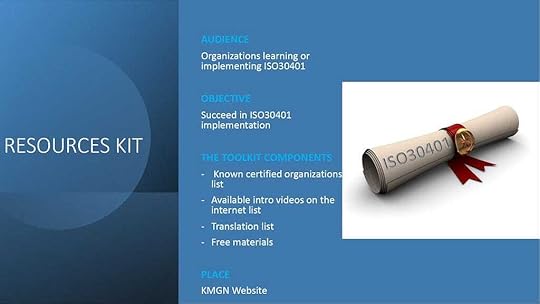 [image error]
[image error]
October 14, 2023
Rachad Najjar: Profiles in Knowledge

This is the 96th article in the Profiles in Knowledge series featuring thought leaders in knowledge management. Rachad Najjar specializes in generative AI, knowledge exchange, knowledge management, artificial intelligence, and organizational learning. Based in Grenoble, France, he leads GE Renewable Energy in organizational learning, knowledge sharing, and virtual collaboration. In this role he is responsible for defining a renewable knowledge architecture with the right set of business-driven knowledge communities.
Rachad has extensive experience in the fields of knowledge management and organizational learning. His professional experience is coupled with scientific discipline and research-based models that have been published by specialized scientific conferences. He earned a PhD in industrial engineering with a focus in knowledge management. His thesis detailed collaborative methods and tools to remotely develop multi-site engineering standards using the case of GE Renewable Energy.
Rachad has been a regular contributor to the SIKM Leaders Community. He has given presentations, participated in calls, answered questions, and shared useful insights.
Recently a member of my local Detroit KM community, Susan Genden, asked me for help in finding a last-minute replacement for a speaker for the community she supports. Based in Farmington Hills, Michigan and serving adults 55 and better throughout the metropolitan Detroit area, SOAR Lifelong Learning Institute offers a year-round, diverse selection of classes, lectures, and explorations along with a large variety of social activities for those with a curious mind and a passion for learning.
Based on my suggestion of Rachad, Susan contacted him, and was delighted when he immediately agreed to step in. On October 20, 2023 at 10 am EDT, he will present via Zoom on AI Trends Today and Tomorrow. Here is the class description:
Artificial Intelligence (AI) has been making significant strides in recent years and is poised to have a substantial impact on various industries and everyday life. Generative AI technology focuses on creating new content, such as images, videos, text, and music, using machine learning algorithms. This class will explore AI and provide examples of current trends such as image generation, text generation, deep fakes, and generative AI tools that are empowering artists and designers.Background
 ProfilesLinkedInSIKM Leaders CommunityFacebookTwitterEducationGrenoble INP — UGA: Doctor of Philosophy (Ph.D.), Industrial Engineering, 2013–2016Université Grenoble Alpes: Master’s degree, Computer Software Engineering, 2011–2012University of Balamand: Master of Science (M.Sc.), Computer Hardware Engineering, 2003–2008ExperienceGE VernovaOrganizational learning leader, 2020 — PresentGlobal Knowledge Sharing Leader, 2013 — PresentLIG Grenoble Informatics Laboratory — Business Process Analyst, 2011–2012Intelligile Excellence — Knowledge Management Specialist, 2008–2011Content3R Knowledge Consulting
Medium
Preliminary Understanding of Generative AI: What & How?Why virtual collaboration is different from remote working or home workingA conversation between a knowledge sharing advocate and a knowledge sharing skepticWhat my day resembles as a Knowledge Manager
RealKM
AI integration strategy for learning and knowledge management solutions [Generative AI & KM series part 1]AI-based KM features for social learning and personal capabilities [Generative AI & KM series part 2]AI-based KM features for knowledge co-development and exchange [Generative AI & KM series part 3]AI-based KM features for knowledge retention and reuse [Generative AI & KM series part 4]AI-based KM features for expertise discovery and dissemination [Generative AI & KM series part 5]AI-based KM features for knowledge discovery and generation [Generative AI & KM series part 6]AI-based KM features for knowledge-centered services [Generative AI & KM series part 7]AI-based KM features for knowledge analytics and intelligence [Generative AI & KM series part 8]Summary and conclusion [Generative AI & KM series part 9]
SIKM Leaders Community Posts
ProfilesLinkedInSIKM Leaders CommunityFacebookTwitterEducationGrenoble INP — UGA: Doctor of Philosophy (Ph.D.), Industrial Engineering, 2013–2016Université Grenoble Alpes: Master’s degree, Computer Software Engineering, 2011–2012University of Balamand: Master of Science (M.Sc.), Computer Hardware Engineering, 2003–2008ExperienceGE VernovaOrganizational learning leader, 2020 — PresentGlobal Knowledge Sharing Leader, 2013 — PresentLIG Grenoble Informatics Laboratory — Business Process Analyst, 2011–2012Intelligile Excellence — Knowledge Management Specialist, 2008–2011Content3R Knowledge Consulting
Medium
Preliminary Understanding of Generative AI: What & How?Why virtual collaboration is different from remote working or home workingA conversation between a knowledge sharing advocate and a knowledge sharing skepticWhat my day resembles as a Knowledge Manager
RealKM
AI integration strategy for learning and knowledge management solutions [Generative AI & KM series part 1]AI-based KM features for social learning and personal capabilities [Generative AI & KM series part 2]AI-based KM features for knowledge co-development and exchange [Generative AI & KM series part 3]AI-based KM features for knowledge retention and reuse [Generative AI & KM series part 4]AI-based KM features for expertise discovery and dissemination [Generative AI & KM series part 5]AI-based KM features for knowledge discovery and generation [Generative AI & KM series part 6]AI-based KM features for knowledge-centered services [Generative AI & KM series part 7]AI-based KM features for knowledge analytics and intelligence [Generative AI & KM series part 8]Summary and conclusion [Generative AI & KM series part 9]
SIKM Leaders Community Posts
1. Continuously invest in education and learning whether the employer sponsored it or not
It’s important to learn how to learn, I chose micro-learning that enables me to acquire micro-skills. I usually choose project-based learning that focuses on achieving a well-defined set of tasks. The theoretical knowledge is already acquired from the academy and the experiential knowledge is acquired in practice. I have formed a conviction that free knowledge is about the know-why and know-what. Free knowledge is a ‘sales pitch’ to some extent. On the other side, paid knowledge offers the know-how and the expert opinion (the consulting industry). I advocate open-source and open-access communities as I believe knowledge should be made available so we can collectively co-construct new knowledge.
2. Three main challenges when trying to implement a Knowledge Graph (KG)
Limited awareness of the knowledge graph applications and use cases: Some business leaders have perceived KG as a mind map for their databases and IT applications. Other leaders thought that KG is only applicable for health sciences where it involves the discovery of a new drug for a disease or repurposing an existing one.Siloed data, lack of APIs (interfaces), lack of unified standards for KG representation: The ‘Mille-feuille’ effect of multiple, competing, fragmented, siloed systems within the organization make it difficult to work with KG especially when dealing with data with different formats and sources.Technical expertise, cross-collaboration, and knowledge sharing: KG requires expertise in data modeling, ontology development, and graph database management. It also requires the collaboration of different functions to integrate their knowledge into a unified schema. knowledge hoarding and self-preservation can quickly hinder the successful implementation of KG.You can follow the progress through this evaluation spreadsheet. To get familiar with the evaluation grid that I have constructed here are some key elements:
Column B: The KM platform/ tool that has integrated Generative AI into its offering.Column C: A brief description of the platform/ tool.Column D: What is the main use case/ area where KM is applicable?Column E — Column AM: The evaluation criteria embedding an AI feature.4. Indicators of knowledge sharing vitality
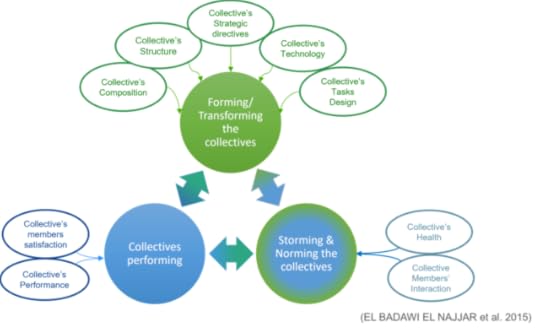
For the complete set of the collective’s characteristics, please refer to Tables 18, 19, and 20 in this report.
5. Knowledge itself can’t be quantified, however, you can measure its impact, absence, or reusability.
Here are some resources that I can recommend:
My recent co-authored book: Chapter 3 — Section 6: How to Measure the knowledge-sharing members’ engagement and community outcomesMeasuring the communities’ members’ engagement & interactionsMeasuring the impact of the community-generated knowledgeIntangible Asset Market Value Study, July 2020. A good study shows the market value of the intangible asset (Intellectual capital and knowledge-based services) evaluated at 90% for the S&P 500.How Much Are You Losing By Failing to Share Knowledge? A nice report from Panopto. There’s a calculator to estimate the cost of searching for information, asking for help, and waiting on expertise.Take the estimation as a directive value and not as an absolute value.It is an indicator for improvement rather than an ROI.At GE Renewable Energy, we interpret taxonomy as an expertise and capabilities engine for the engineering and technology community. The taxonomy acts as the curator of different content types, learning sources, and knowledge nuggets. For example, if a control system engineer would like to develop expertise in a specific product component, through the taxonomy it’s possible to pull together people, design practices, standards, codes, and training materials to dynamically form the learning framework around that specific product component. The taxonomy is also considered a conversational process to bring experts together and raise awareness around their skills, areas of interest, and learning topics. We organize taxonomy workshops, on one hand, to refine and reiterate every knowledge-sharing community’ taxonomy and on another hand as a mechanism to bring visibility around what we know and are interested in for technical development and capability building.
7. Does a company have experience, or do its people?
In order to say that the company has experience is when the company becomes a Learning Organization. The transformation from a hero organization to a learning organization goes through phases:
Phase 1: A shift from a Systems Organization to a Networked Organization.Phase 2: A shift from a Networked Organization to a Fearless Organization.Phase 3: A shift from a Fearless Organization to a Learning Organization.Learning organizations are my current occupation.
Hero Organization: For example, a medical clinic hires a senior medical doctor and the necessary supporting staff to support the doctor. The expertise is singular and revolves around one senior expert. A startup will recruit a senior sales manager and junior sales team to support an expert. The sales activity is developed around the personal network of the senior sales expert. These individuals at the top are the heroes (rainmakers).Systems Organization: Would like to streamline the development of their expertise through common and repeated processes and tools. They’d like to move from individual expert dependencies to a reproduced set of expertise. However, organizations are complex, and knowledge work evolves across departments, organizations, teams, and locations before the process can be documented or updated. Work is often invisible, and we don’t see it because it’s being completed in the minds of decision-makers and software applications before it can even be documented. It’s often never documented when relative panic sets in as key experts leave or retire.Networked Organization: Works to overcome the challenge of fast-changing work processes by attempting to flatten the organizational hierarchy, connecting expertise and know-how, while working in network design. Expertise is acquired by engaging in common practices, collaborating, and learning on the job, often within knowledge community-type structures. However, networked organizations remain involved in complicated operational issues and pressing customer issues, rarely having the time, vision, or flexibility to question the existing practices and develop a new set of expertise-based approaches.Fearless Organization: provides a degree of flexibility and liberty to question the existing practices by encouraging inquiries and ongoing discovery. Engineers are not afraid to investigate their conventional working methods it’s encouraged (Edmondson, 2018). A safe organizational climate is instantiated within the organization, and this enables the engineers to learn more rapidly through frequent questioning and evolution.Learning Organization: Is based on the capacity of the organization to reinvent and transform itself through the collective learnings of employees. The learning organization IS NOT a university organization that graduates its engineers and workers. Rather it is best characterized as a competitive organization that continuously innovates new products and services, always with a customer focus. Expertise systematically evolves into a new set of competitive skills and competencies. Retaining and re-using knowledge happens in the flow of daily work. It’s embedded.As long as people are interacting, reflecting, discussing, and working together, new knowledge will be generated (constructivist epistemology). Knowledge has to be captured, organized, formalized and re-used until it evolves into a new form of knowledge — commonly known as knowledge management. The KM discipline is like a fluid that takes the shape of its recipient, is conditioned by its context, and is profiled by its application. Knowledge management (KM) serves the purpose for which it’s designed.
At 3R Knowledge consulting, we design knowledge management for organizational excellence. We emphasize that KM behaviors are integrated and embedded within the different organizational aspects. 3R Knowledge management methodology addresses 6 organizational areas: Organizational Agility, Organizational Learning, Organizational Performance, Organizational Intangible Assets, Organizational Change, and Organizational Behaviors.
If out of fashion means that KM is no longer a marketing buzzword, that’s fine. KM will continue to exist as people continue to constitute organizations. Organizations express their pain and needs in different ways however they are inherently referring to one shape and form of Knowledge management. Our role as KM leaders is to articulate the organizational needs using their vocabularies.
9. What would you do as Knowledge Manager in your first 90 days?
I can recommend this high-level roadmap as illustrated below. The #1 recommendation remains partnership with leaders, managers and field workers.

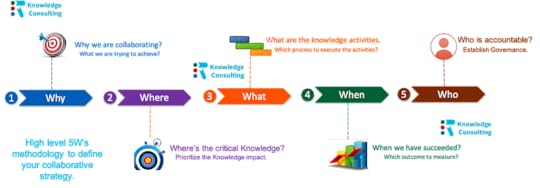 LinkedInArticles7 Guiding Principles of a Successful Enterprise AI StrategyUnderstanding the NFT Community’ dynamics: Insights from 30 days of immersionGE Now Offering Knowledge Management Consulting ServicesDocumentsA Taxonomy for the Future of LearningImagesPostsCommentsCollaborative ArticlesHow can you use a business capability map to improve your business?How do you measure the impact of bite-sized learning?PublicationsResearchGateCollaborative methods and tools to remotely develop multi-sites engineering standards: The case of GE Renewable Energy — HydroAn Approach for Defining a Collaborative Platform to Support the Development of Corporate Engineering StandardsAcademia.eduSemantic ScholarGoogle ScholarPresentationsSlideShareSIKM Leaders CommunityNovember 2019 — Digital Workplace Experience: Building a Collaborative Culture at GE with Dan Ranta — SlidesJanuary 2022 — A system-thinking approach to a learning organization transformation — SlidesVideos3R Knowledge ConsultingYouTubeSanthosh Shekar Interview, Part 1https://medium.com/media/542ca2118d67a34d6e8cacfdeadf39cb/hrefSanthosh Shekar Interview, Part 2https://medium.com/media/831edfe3afecfcb7ced946c0bfe2b222/hrefSanthosh Shekar Interview, Part 3https://medium.com/media/ed6ec92294d2467dc5d8c21ab74786c3/hrefBook
LinkedInArticles7 Guiding Principles of a Successful Enterprise AI StrategyUnderstanding the NFT Community’ dynamics: Insights from 30 days of immersionGE Now Offering Knowledge Management Consulting ServicesDocumentsA Taxonomy for the Future of LearningImagesPostsCommentsCollaborative ArticlesHow can you use a business capability map to improve your business?How do you measure the impact of bite-sized learning?PublicationsResearchGateCollaborative methods and tools to remotely develop multi-sites engineering standards: The case of GE Renewable Energy — HydroAn Approach for Defining a Collaborative Platform to Support the Development of Corporate Engineering StandardsAcademia.eduSemantic ScholarGoogle ScholarPresentationsSlideShareSIKM Leaders CommunityNovember 2019 — Digital Workplace Experience: Building a Collaborative Culture at GE with Dan Ranta — SlidesJanuary 2022 — A system-thinking approach to a learning organization transformation — SlidesVideos3R Knowledge ConsultingYouTubeSanthosh Shekar Interview, Part 1https://medium.com/media/542ca2118d67a34d6e8cacfdeadf39cb/hrefSanthosh Shekar Interview, Part 2https://medium.com/media/831edfe3afecfcb7ced946c0bfe2b222/hrefSanthosh Shekar Interview, Part 3https://medium.com/media/ed6ec92294d2467dc5d8c21ab74786c3/hrefBookKnowledge Management and Research Innovation in Global Higher Education Institutions edited by Lawrence Jones-Esan, Vipin Nadda, and Kendra S. Albright
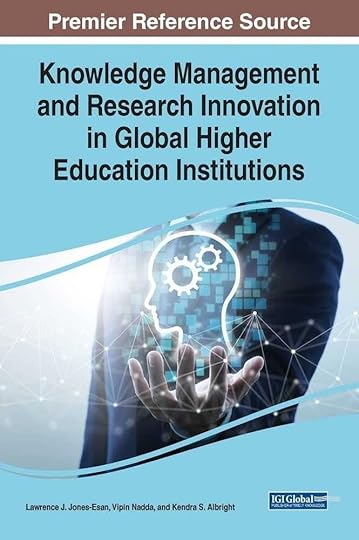 Preface with Larry Jones-EsanChapter 3: Maximize Knowledge Sharing and Learning Opportunities[image error]
Preface with Larry Jones-EsanChapter 3: Maximize Knowledge Sharing and Learning Opportunities[image error]
October 13, 2023
Knowledge Management Thought Leader 44: Carla O’Dell
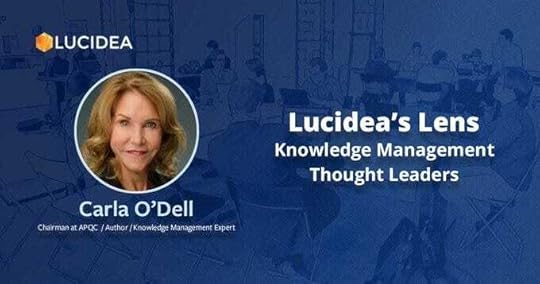
Carla O’Dell founded APQC along with her late husband, Jack Grayson. She is one of the world’s leading experts in using knowledge to drive productivity and competitiveness.
Carla leads APQC’s Board of Directors in its governance and oversight responsibilities. Previously, she served as APQC’s CEO from 2012 to 2018, president from 1994–2012, and in leadership roles since joining in 1978.
A practical visionary, she plays a strong role in APQC’s research. She works to inspire the next generation of ideas, research, and people so that APQC remains true to its mission: to research and embrace advances that make people more productive and that enrich their work life.
Over her 40-year career with APQC, Carla launched many of APQC’s signature research areas and tools. In 1995, under her direction, APQC launched its first knowledge management best practices consortium. Since then, APQC has worked with more than 500 organizations and produced the world’s largest body of actionable best practices in designing and implementing KM strategies, and measuring the impact of KM.
Carla is an active author, contributor to APQC’s knowledge management blog, and frequent interviewee for national and industry press. Her popular Big Thinkers, Big Ideas interview series captures new insights on learning, knowledge, innovation, and leadership from some of the top business minds. She was the executive champion for the formation of APQC’s Open Standards Benchmarking® database, which standardized the processes and measurements that global organizations use to benchmark and improve performance.
 EducationStanford University — BA, PsychologyUniversity of Oregon — MS, Experimental PsychologyUniversity of Houston — PhD, Industrial and Organizational PsychologyProfiles
LinkedIn
APQC
Twitter
Profiles in Knowledge
Books
EducationStanford University — BA, PsychologyUniversity of Oregon — MS, Experimental PsychologyUniversity of Houston — PhD, Industrial and Organizational PsychologyProfiles
LinkedIn
APQC
Twitter
Profiles in Knowledge
BooksIf Only We Knew What We Know: The Transfer of Internal Knowledge and Best Practice with C. Jackson Grayson
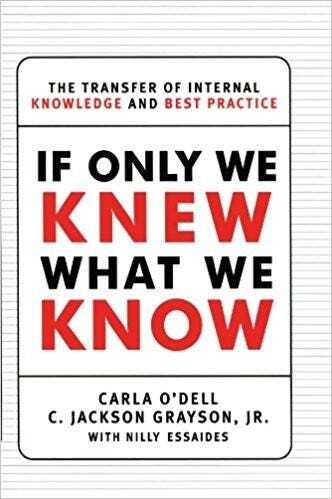
The New Edge in Knowledge: How Knowledge Management Is Changing the Way We Do Business with Cindy Hubert
The Executive’s Role in Knowledge Management with Paige Leavitt
Stages of Implementation: A Guide for Your Journey to Knowledge Management Best Practices with Cindy Hubert and Susan Elliot
Knowledge Management: A Guide for Your Journey to Best-Practice Processes with Cindy Hubert and Susan Elliot
Handbook of Knowledge Management Vol. 1 edited by Clyde Holsapple — Chapter 31: Identifying and Transferring Internal Best Practices — with C. Jackson Grayson
Handbook of Knowledge Management Vol. 2 edited by Clyde Holsapple — Chapter 44: Achieving Knowledge Management Outcomes — with Susan Elliot and Cindy Hubert; Chapter 51: Successful KM Implementations: A Study of Best Practice Organizations — with FariDa Hasanali, Cindy Hubert, Kimberly Lopez, Peggy Odem, and Cynthia Raybourn
Knowledge Management Lessons Learned: What Works and What Doesn’t edited by Michael E. D. Koenig and T. Kanti Srikantaiah — Chapter 5: Successfully Implementing Knowledge Management: Lessons Learned and Best Practices with Cindy Hubert
Content APQC Blog LinkedIn Posts Videos Big Thinkers, Big Ideas: Host and Thought Leader Herself, Carla O’Dell, Gets Interviewed Definition of a Good Idea How Social Networking Makes Us Smarter Expertise Shortages and What It Does To Knowledge Management Programs How Individuals Learn How Organizations Learn How Communities Learn Social Networking: What Does It Mean for Knowledge Management? How Mobile Devices Are Changing Knowledge Management Social Media: Friend, Fad, or Foe of Knowledge Management? Social Media and Information Security: Can They Peacefully Coexist? Getting Started with Analytics Knowledge Management Best Practices The 7 Habits of Highly Effective Knowledge Management Organizations KMWorld 2015 Keynote ArticlesKMWorld Cognitive computing — Part 1 Cognitive computing and the evolution of knowledge work Cognitive Computing — Part 2 Applying cognitive computing to KM Cognitive Computing — Part 3 Challenges and lessons in cognitive computing Using KM to Leverage and Develop Experts A Knowledge Strategy Senior Leaders Can Get Behind KM is Back, Baby by Andy MooreOthers Order From Chaos: Controlling Your Content Overcoming cultural barriers to sharing knowledge with Richard McDermott Knowledge transfer: Discover your value proposition with Jack Grayson California Management Review: If Only We Knew What We Know: Identification and Transfer of Internal Best Practices with Jack Grayson Harvard Business Review: If Only We Knew What We Know: Identification and Transfer of Internal Best Practices with Jack Grayson Interview KM Overview Presentations KMWorld 2001 Keynote: Successfully Implementing KM — Slides 2004 Keynote: Driving Performance with Knowledge Management — Slides 2009 Envisioning the Enterprise of the Future — Slides 2011 Keynote: Let Your Networks Be Your Guide: Search in a 2.0 World — Slides 2013 Keynote: Transforming the Way We Collaborate — Slides 2015 Keynote: Learn It! Do It! Share It! People and organizations learn differently. (Benedict Carey: How We Learn )You have learned something when you are able to recall it when you need it.People will remember the first thing you tell them and the last thing you tell them.Knowledge management is how organizations learn and remember.Organizations often create business rules as a result of something that went wrong.KM can help people learn by alerting them when something has changed: more dynamic than formal training and at the teachable moment.KM should be there at the teachable moment. Avoid dead ends, empty shelves, and desert islands.Communities are still KM’s killer app. Members’ allegiance to the group makes it possible for them to help others.Members of the group bring outside ideas to the group, which are vetted by the group, leading to improvement and innovation.People approaches make system approaches work. Technology matters, but change management to implement it is more important. SIKM Leaders Community December 2018: High-Touch KM for a High-Tech World — with Lauren Trees — Slides
February 2013: Trends in knowledge management — with Cindy Hubert — Slides
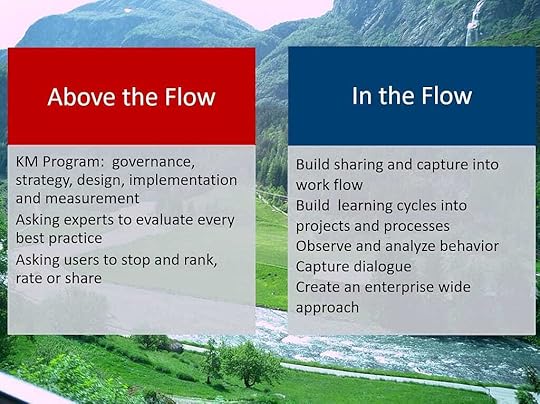 [image error]
[image error]
October 6, 2023
Knowledge Management Thought Leader 43: Michelle Ockers
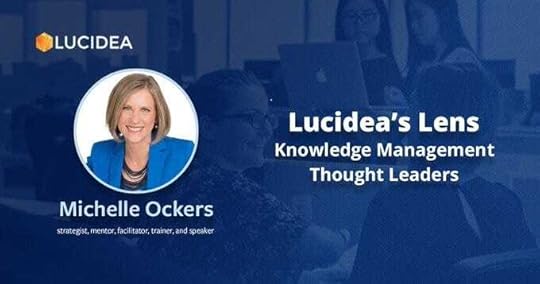
Michelle Ockers is Co-Founder and Director of Learning Uncut. As an Organizational Learning Strategist and Learning and Development (L&D) Team Capability Builder, she helps leaders build a high impact L&D function.
Michelle is a strategist, mentor, facilitator, trainer, and speaker who believes that everyone deserves the opportunity to learn and perform at their best. She is based in Tuross Head, New South Wales, Australia.
Michelle introduced Communities of Practice for strategic capabilities at Coca-Cola Amatil, including supply planning, manufacturing, and engineering. She coached others, including business leaders and subject matter experts, to build and sustain effective communities. Michelle was an early proponent of Working Out Loud (WOL) in Australia. She established WOL Circles both inside organizations and across the learning profession.
 BackgroundEducationUniversity of Southern Queensland — Bachelor of Business in Economics and Human Resource Management, 1987 with University MedalExperience (selected)Learning Uncut , Co-Founder, Director, Consultant, and Podcast HostEmerging Stronger, Co-CreatorAustralian Institute of Training & Development (AITD), Divisional PresidentQantas , Training ManagerCoca-Cola Amatil , National Supply Chain Technical Capability Manager, Technical Training ConsultantAndragogy , Learning ConsultantProfiles
Website
Learning Uncut
LinkedIn
Twitter
Instagram
Facebook
AITD
Profiles in Knowledge
Content
Blog
Learning Uncut Blog
Learning and Development Resources: Links & Downloads
SlideShare
LinkedIn
Articles
Posts
Documents
Conferences
ATD
Learning Technologies
Podcasts
Learning Uncut Podcast | Learning & Development Insights
Five Powerful L&D Insights
Peer Learning: Working Out Loud — Katharina Krentz & John Stepper
Harnessing Tacit Knowledge to Make Work Safer — David Broadhurst & Rae Grech
Storytelling — Mark Schenk
Making Work Visible — Jane Bozarth
Using Podcasts for Learning Delivery
Learning Out Loud with Michelle Ockers
by Jackie HarmanVideos
YouTube: Michelle Ockers
YouTube: Learning Uncut
Learning Culture Campaign
Becoming a Learning Organization
Useful Models to talk about Communities of Practice in an Organization
Supporting the whole organization to improve its performance
Association for Talent Development
About Michelle Ockers
Perspectives 2020 — Highlights Captured from Sydney
Blog Categories
Blogging
Collaboration
Community
Curation
Knowledge Management
Leadership
Networking
PKM
Social Learning
Tools
Working Out Loud
Blog Posts
Community of Practice Case Study
Community of Practice Progress Review (70:20:10 Certification Pathway)
Community of Practice Evaluation Strategy
Community of Practice Hubs
Smart Leaders Leverage Abundant Knowledge
Michelle Works Out Loud — A Tool to Capture & Communicate What You Know
Benefits of Internal Collaboration
Articles
L&D Development Resources
Are You Ready to Build a Learning Culture?
with Nigel Paine
What Learners Really Want
Working Out Loud Circles
Articles by Others
Michelle Ockers Found a Voice for Her Business and Industry
by Katie McMurray
How to Become a Learning Organization (An Interview with Michelle Ockers)
by Jeffrey Dalto
The 4th Annual Internet Time Alliance Jay Cross Memorial Award goes to Michelle Ockers
by Jane Hart
What is a Community of Practice? by Karen Jeannette
L&D: Leverage Community to Breakthrough
BackgroundEducationUniversity of Southern Queensland — Bachelor of Business in Economics and Human Resource Management, 1987 with University MedalExperience (selected)Learning Uncut , Co-Founder, Director, Consultant, and Podcast HostEmerging Stronger, Co-CreatorAustralian Institute of Training & Development (AITD), Divisional PresidentQantas , Training ManagerCoca-Cola Amatil , National Supply Chain Technical Capability Manager, Technical Training ConsultantAndragogy , Learning ConsultantProfiles
Website
Learning Uncut
LinkedIn
Twitter
Instagram
Facebook
AITD
Profiles in Knowledge
Content
Blog
Learning Uncut Blog
Learning and Development Resources: Links & Downloads
SlideShare
LinkedIn
Articles
Posts
Documents
Conferences
ATD
Learning Technologies
Podcasts
Learning Uncut Podcast | Learning & Development Insights
Five Powerful L&D Insights
Peer Learning: Working Out Loud — Katharina Krentz & John Stepper
Harnessing Tacit Knowledge to Make Work Safer — David Broadhurst & Rae Grech
Storytelling — Mark Schenk
Making Work Visible — Jane Bozarth
Using Podcasts for Learning Delivery
Learning Out Loud with Michelle Ockers
by Jackie HarmanVideos
YouTube: Michelle Ockers
YouTube: Learning Uncut
Learning Culture Campaign
Becoming a Learning Organization
Useful Models to talk about Communities of Practice in an Organization
Supporting the whole organization to improve its performance
Association for Talent Development
About Michelle Ockers
Perspectives 2020 — Highlights Captured from Sydney
Blog Categories
Blogging
Collaboration
Community
Curation
Knowledge Management
Leadership
Networking
PKM
Social Learning
Tools
Working Out Loud
Blog Posts
Community of Practice Case Study
Community of Practice Progress Review (70:20:10 Certification Pathway)
Community of Practice Evaluation Strategy
Community of Practice Hubs
Smart Leaders Leverage Abundant Knowledge
Michelle Works Out Loud — A Tool to Capture & Communicate What You Know
Benefits of Internal Collaboration
Articles
L&D Development Resources
Are You Ready to Build a Learning Culture?
with Nigel Paine
What Learners Really Want
Working Out Loud Circles
Articles by Others
Michelle Ockers Found a Voice for Her Business and Industry
by Katie McMurray
How to Become a Learning Organization (An Interview with Michelle Ockers)
by Jeffrey Dalto
The 4th Annual Internet Time Alliance Jay Cross Memorial Award goes to Michelle Ockers
by Jane Hart
What is a Community of Practice? by Karen Jeannette
L&D: Leverage Community to Breakthrough Applying Learning Science to Workplace Communities
Applying Learning Science to Workplace CommunitiesEnterprise collaboration tools keep people connected across the many spaces where they now work. It feels like learning in the flow of work may finally be within our grasp, particularly as we are swimming in content and people are increasingly comfortable using collaboration technology.
Just as a successful gardener applies findings from the natural science of botany, taking an approach informed by learning science will help learning in a community to grow and thrive. Let’s explore three compelling myths that too often lead us up the garden path and see how learning science can help us nip them in the bud!
Myth #1 — Consuming content means learning is happening
When the pandemic hit, we saw an explosion in people accessing digital content. Research by Fosway in May 2020 showed that 71% of L&D leaders experienced an increased demand for digital learning content from learners. It’s easy to measure content ‘hits’ — and of course, helpful to know what content people are finding useful. Accurate, relevant content is critical to learning.
However, consumption of content alone does not mean that learning is happening. Even if we are thoughtfully curating content and sharing it in workplace communities, we are missing a significant opportunity to seed learning in richer ways.
Questions are a powerful way to improve recall and deepen understanding. Try these two approaches to using questions when you post content in communities:
Reflection — Invite individual reflection on key takeaways and how they compare to their own experience.Elaboration — Ask people whether they agree with key points in the content, and why or why not, inviting them to explain their thinking.Myth #2 — We no longer need knowledge, as we can look it up
We can look up almost anything online inside or outside of our organization when and where we need it. It’s enticing to think that there’s no point learning and memorizing things when we can look everything up online. Of course, we can — and should — look up facts and simple processes online rather than having to remember them.
However, information and knowledge are different things. When we look things up what we find is largely facts or information. We have to judge the validity of what we find and interpret it to make it meaningful.
This requires that we have a ‘map of the world’ to make sense of and use what we find. Knowledge is this map, composed of existing mental frameworks, experience and expertise. In short, we need knowledge to do something useful with information.
Grow knowledge in workplace communities using proven methods such as:
Retrieval practice — Post case studies and scenarios or run activities where people can seek input on challenges, providing an opportunity to retrieve and apply knowledge, deepening understanding.Elaboration — Encourage people to relate new concepts or ideas to existing knowledge and create connections by asking how they could use the concepts in their work.Myth #3 — Digital means people are learning differently
Technology has provided new digital spaces for people to work and learn. It provides access to a far greater volume of content, both inside and outside of organizations. Searching the internet has been likened to trying to drink from a firehose. By necessity, how we search for and filter information has changed as we seek to quickly decide what content is worthy of our attention.
However, it has not fundamentally changed the mechanisms by which we learn. In his book Millennials, Goldfish & Other Training Misconceptions, Clark Quinn debunks the myth that digital means we learn differently. He points out that “learning itself, which changes the brain wiring, is a process of action and reflection.” While digital spaces may have changed the environment in which learning is occurring, “it’s using the same mechanisms of neural strengthening.”
So, if our brains work in the same way, we need to tune into how we can encourage people to learn in workplace communities. We can do this by sowing questions and activities in ways such as:
Spaced practice — Set challenges or run activities that provide multiple practice opportunities over a period of time.Feedback — Invite people to demonstrate or walk through how they do something and guide constructive peer feedback.[image error]September 29, 2023
Knowledge Management Thought Leader 42: Agnes Molnar
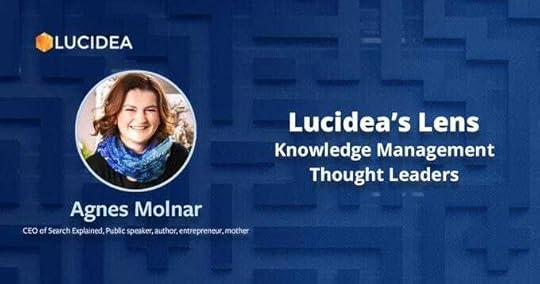
Agnes Molnar, CEO of Search Explained, specializes in information architecture and enterprise search. She is a consultant, speaker, mentor, author, and entrepreneur. Her goal is to create awareness regarding search options, techniques, and proven practices. She lives in Eindhoven, Netherlands.
Agnes studied information technology at the Budapest University of Technology and Economics and before the completion of her Masters, she had already started off in the field of IT. She was certified as a Scrum Master in 2012 and MCT (Microsoft Certified Trainer) in 2006.
Agnes is a founding member of The Search Network, a global community of independent search professionals and contributor to the annual report, Search Insights. She’s a Microsoft Regional Director and has been awarded a Most Valuable Professional (MVP) by Microsoft every year since 2008. Agnes is a regular speaker at conferences and workshops around the globe. Her personal blog covers leadership, mentoring, technical writing, public speaking, and more.
Her specialties include:
SearchSharePointMicrosoft 365Microsoft SearchInformation ArchitectureKnowledge ManagementFindability EducationBudapest University of Technology and Economics, MSc, Computer Science, 1998–2005ExperienceFounder and Managing Consultant, Search ExplainedFounding Member, The Search NetworkFounding Member, RoundRegional Director, MicrosoftMentor, Microsoft for StartupsCo-organizer, IKO (Innovations in Knowledge Organization) ConferenceProfiles
LinkedIn
Aghy
Amazon
Twitter
Facebook
Instagram
Search Explained
The Search Network
Books
EducationBudapest University of Technology and Economics, MSc, Computer Science, 1998–2005ExperienceFounder and Managing Consultant, Search ExplainedFounding Member, The Search NetworkFounding Member, RoundRegional Director, MicrosoftMentor, Microsoft for StartupsCo-organizer, IKO (Innovations in Knowledge Organization) ConferenceProfiles
LinkedIn
Aghy
Amazon
Twitter
Facebook
Instagram
Search Explained
The Search Network
Books
Google Search Appliance Retirement Explained: What’s Next?

Improve It! A collection of essays on using analytics to accomplish more with SharePoint edited by Loren Johnson and Jean-Marc Krikorian — Chapter 6: Enterprise Search
 Content
Search Explained Blog
CMS Wire
Reworked
Content Formula
Medium
SlideShare
YouTube
LinkedIn
Articles
Posts
LinkedIn Newsletter: Leadership Emotions
— The human side of being a leaderConferences
Taxonomy Boot Camp
Enterprise Search & Discovery
KMWorld
IKO (Innovations in Knowledge Organization)
Podcasts
Mavens Do It Better
#MVPbuzzChat — buckleyPLANET
WITGirls
SharePoint: When search becomes intelligent
Shared Insights: SharePoint 2016 Search
Search Insights Articles
Communicating enterprise search for success
The challenge of information quality
Microsoft Search in Office 365
Microsoft search, Search team skills, Achieving enterprise search satisfaction
Microsoft SharePoint and Office 365 search
The Five Cs of Enterprise Search: Culture, Content, Challenges, Capabilities, Confines
Content
Search Explained Blog
CMS Wire
Reworked
Content Formula
Medium
SlideShare
YouTube
LinkedIn
Articles
Posts
LinkedIn Newsletter: Leadership Emotions
— The human side of being a leaderConferences
Taxonomy Boot Camp
Enterprise Search & Discovery
KMWorld
IKO (Innovations in Knowledge Organization)
Podcasts
Mavens Do It Better
#MVPbuzzChat — buckleyPLANET
WITGirls
SharePoint: When search becomes intelligent
Shared Insights: SharePoint 2016 Search
Search Insights Articles
Communicating enterprise search for success
The challenge of information quality
Microsoft Search in Office 365
Microsoft search, Search team skills, Achieving enterprise search satisfaction
Microsoft SharePoint and Office 365 search
The Five Cs of Enterprise Search: Culture, Content, Challenges, Capabilities, ConfinesCulture: When we provide Enterprise Search services (any service), it’s critical to understand the culture of the organization. The goal is always to serve the (human) users, to make their work easier and lives better.
Content: Enterprise Search is all about content and its presentation to the users in the proper context. Knowing the content means knowing what to present to the users. Moreover, if we understand the users and their intent (context) as well, we are also able to plan what they need in what case, what content has to be boosted (by a SharePoint search query rule, for example), what has to be removed or filtered out, etc. — and then we’re on the right track to provide a good Search solution.
Challenges: Each organization has smaller or bigger challenges. Some of these are findability demands (”We want to be able to find this and that”). Some are business process requests (”In this step we need this and that information.”). Some others might be not related to Search at first sight (”We need help with this decision-making process”). What’s common in each of these challenges is that we can help solving them with the help of Enterprise Search. — Maybe not by a traditional Search page, but with some application that uses Search behind the scenes (Search Driven Applications). Of course, we cannot solve everything with Enterprise Search, but we definitely can solve much more than we’d think first.
Capabilities: Every organization has unique capabilities as well. When providing Enterprise Search services, we have to rely on these capabilities, as they can amplify the success. Understanding these capabilities is critical. Similar to our own personal development, we have to rely on these strengths and ride them.
Confines: We find boundaries everywhere. Confines in business are to set the rules, to keep the organization and its employees safe. Being either an employee or an external consultant, we have to know and respect these boundaries. Of course, some of them might make working in the Enterprise Search arena very hard or at least challenging. The key is to be collaborative, in order to provide the maximum value while respecting the boundaries.
Modern Knowledge Management
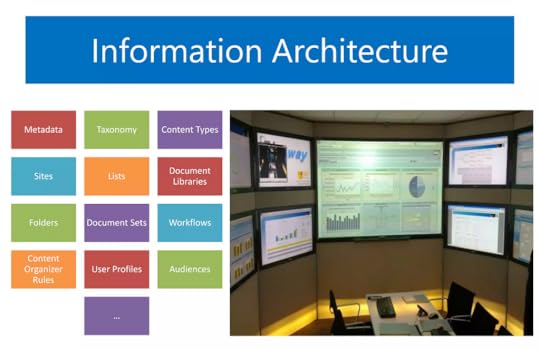
 [image error]
[image error]



